Experimental Research on Concrete Beams Reinforced with High Ductility Steel Bars and Strengthened with a Reactive Powder Concrete Layer in the Compression Zone
Abstract
1. Introduction
2. Materials
2.1. RPC
2.2. Ordinary Concrete
2.3. Reinforcing Steel
3. Preparation of the Beams
3.1. Optimum Longitudinal Reinforcement Ratio and Ultimate Limit State Model in the Beam with RPC Strengthening in the Compression Zone
3.2. Construction of Beams
4. Description of Tests
4.1. Test Stand for the Loading of the Beams. Methods of Measuring the Beams’ Deflection, Strains, and Curvature
4.2. Method of Loading the Beams
4.3. Ultrasonic Testing
4.4. Photogrammetric Analysis
5. Research Results and Discussion
5.1. Beam #1
5.2. Beams #2 and #3
6. Conclusions
- (1)
- The use of a relatively thin RPC layer of a compressive strength of 200 MPa in the compression zone of beams #1 and #2 contributed to a significant increase in their absorption of energy, and their very stable behaviour in the post-critical state compared to reference beam #3, in which only OC was used. For this purpose, the RPC layer also had to be protected against local debonding and buckling by a dense system of the stirrups penetrating the RPC and OC layers, and the dispersed steel fibre reinforcement in the RPC mix was used against local premature crushing. In such a case, the RPC layer placed in the compression zone of the beam allowed the structural capability of the high-ductility reinforcing steel to be fully utilised.
- (2)
- In the design of the test beams with the RPC strengthening, it was decided to use a reinforcement ratio that was possibly close to the optimal one, taking into account the criteria of maintaining the bending resistance of beam and the cost of materials. The calculations gave a result for which the changes in the cost of the fabrication of the analysed beams with RPC of the desired bending resistance did not change significantly for a tension reinforcement ratio greater than 0.015.
- (3)
- The original proposal for a visualization of the beams’ cracking by means of photogrammetry may allow us to analyse the processes of this type at any stage of loading laboratory tested concrete structural elements using available and relatively cheap photographic equipment. The applied research procedure proved to be particularly effective in assessing the development of the cracks in the beams in their post-critical state, where contact measurement is not possible for safety reasons, due to the high probability of the sudden exhaustion of the load resistance.
- (4)
- The positions of the neutral axis of normal stress in the bent beams’ cross-sections were calculated based on the strains measured, showing that this axis is situated higher in the beams with the top RPC layer compared to the reference beam made entirely of OC. This difference has a noticeable impact on the lever arm of the stress-compressive and tensile-resultant forces, where it is grater in beams #1 and #2 than in beam #3. This translates into an approximately 12% increase in the global stiffness and bending resistance of the beams with the RPC.
- (5)
- The comparative results of the ultrasonic wave velocity changes have indirectly confirmed the difference in the position of the normal stress neutral axis for the beams with and without the strengthening RPC layer. The ultrasonic measurements have also showed the perspective possibilities of using the relatively simple measurements of longitudinal wave velocity changes along the height of the beams in the diagnostics of this type of structural elements under bending, as well as in the indirect evaluation of the degree of the utilisation of their bending resistance.
- (6)
- The construction solution proposed in the article may prove to be helpful in the design of new buildings where the height of the structural members’ cross-section is a limitation, or to ensure the stable behaviour of the structure in the post-critical state. This solution may also be useful for the strengthening of existing reinforced OC beams; however, this would require further research and analysis in relation to the appropriate bonding of the new RPC layer to the existing OC element.
Author Contributions
Funding
Conflicts of Interest
Appendix A
List of Symbols
the cross-sectional area of the tension rebars; [m2]; | |
the objective function describing the cost of the beam’s unit section; | |
the price per m3 of OC; | |
the price per m3 of RPC; | |
the price per m3 of reinforcing steel; | |
the dynamic modulus of the elasticity of the material in an undamaged (virgin) state; [Pa]; | |
the dynamic modulus of the elasticity of the material in a damaged state; [Pa]; | |
the modulus of the elasticity of RPC; [Pa]; | |
the modulus of the elasticity of the reinforcing steel; [Pa]; | |
| , | the loads from the actuators; [N]; |
the resultant force of normal stress in the compressed concrete; [N]; | |
the resultant force of normal stress in the tension steel rebars; [N]; | |
the bending moment in the beam’s cross-section; [Nm]; | |
the beam’s bending moment resistance at the limit state, according to Figure 4a; [Nm]; | |
the bending moment at the middle of beam’s span; [Nm]; | |
the distance of center of gravity of longitudinal main rebars’ cross-section from the tension face of the beam; [m]; | |
the distance of the center of gravity of the longitudinal secondary rebars’ cross-section from the compression face of the beam; [m]; | |
the width of the beam’s cross-section; [m]; | |
the dimensionless objective function proportional to for the given values of , , , , , , , and ; [-]; | |
the longitudinal wave velocity in the undamaged (virgin) material; [m/s]; | |
the longitudinal wave velocity in the damaged material; [m/s]; | |
the effective depth of the beam’s cross-section; [m]; | |
the compressive strength of RPC; [Pa]; | |
the yield point of the reinforcing steel; [Pa]; | |
the height of the beam’s cross-section; [m]; | |
the thickness of the RPC layer; [m]; | |
| , | the deflection of the beam under the actuators; [m]; |
the deflection of the beam at the middle of the span; [m]; | |
the corrected deflection of the beam at the middle of the span determined in relation to the actual support position; [m]; | |
| , | the deflection of the beam at the axis of the supports; [m]; |
the horizontal coordinate used in the photogrammetric analysis; [px]; | |
the vertical coordinate used in the photogrammetric analysis; [px]; | |
the position of the neutral axis as its distance from the beam’s compression face; [m]; | |
| , , , | the normal strains along the beam’s axis at the middle of the span on the upper surface of the beam (compression face); at the level of the longitudinal upper rebars; at the level of the 10.5 cm from the upper surface of the beam; and at the level of the longitudinal bottom rebars, respectively; [-]; |
the normal strain in the concrete at the compression face of the beam, at the moment of the reaching of the limit state, according to Figure 4a; [-]; | |
the normal strain in the tension rebars; [-]; | |
the normal strain in the tension rebars at the moment of the reaching of the limit state, according to Figure 4a; [-]; | |
the normal strain in the rebars at the maximum load; [-]; | |
the curvature of the beam’s upper surface at the middle of the span; [m−1]; | |
the longitudinal tension reinforcement ratio; [-]; | |
the stress in the concrete at the compression face of the beam at the moment of the reaching of the limit state, according to Figure 4a; [Pa]; | |
the normal stress in the tension rebars; [Pa]. |
References
- Richard, P.; Cheyrezy, M. Composition of reactive powder concretes. Cem. Concr. Res. 1995, 25, 1501–1511. [Google Scholar] [CrossRef]
- Yoo, D.Y.; Yoon, Y.S. A review on structural behavior, design, and application of ultra-high-performance fiber-reinforced concrete. Int. J. Concr. Struct. Mater. 2016, 10, 125–142. [Google Scholar] [CrossRef]
- Denisiewicz, A. Betony z proszków reaktywnych i ich zastosowanie w konstrukcjach zespolonych. Przegląd Bud. 2014, 11, 18–23. (In Polish) [Google Scholar]
- Kusumawardaningsih, Y.; Fehling, E.; Ismail, M.; Aboubakr, A.A.M. Tensile strength behavior of UHPC and UHPFRC. Procedia Eng. 2015, 125, 1081–1086. [Google Scholar] [CrossRef]
- Ridha, M.M.S.; Sarsam, K.F.; Al-Shaarbaf, I.A.S. Experimental study and shear strength prediction for reactive powder concrete beams. Case Stud. Constr. Mater. 2018, 8, 434–446. [Google Scholar] [CrossRef]
- Lampropoulos, A.P.; Paschalis, S.A.; Tsioulou, O.T.; Dritsos, S.E. Strengthening of reinforced concrete beams using ultra high performance fibre reinforced concrete (UHPFRC). Eng. Struct. 2016, 106, 370–384. [Google Scholar] [CrossRef]
- Yunsheng, Z.; Wei, S.; Sifeng, L.; Chujie, J.; Jianzhong, L. Preparation of C200 green reactive powder concrete and its static-dynamic behaviors. Cem. Concr. Compos. 2008, 30, 831–838. [Google Scholar] [CrossRef]
- Xie, J.; Fu, Q.; Yan, J.B. Compressive behaviour of stub concrete column strengthened with ultra-high performance concrete jacket. Constr. Build. Mater. 2019, 204, 643–658. [Google Scholar] [CrossRef]
- Hor, Y.; Teo, W.; Kazutaka, S. Experimental investigation on the behaviour of reinforced concrete slabs strengthened with ultra-high performance concrete. Constr. Build. Mater. 2017, 155, 463–474. [Google Scholar]
- Bărbos, G.A. Long-term behavior of ultra-high performance concrete (UHPC) bended beams. Procedia Technol. 2016, 22, 203–210. [Google Scholar] [CrossRef]
- Al-Osta, M.A.; Isa, M.N.; Baluch, M.H.; Rahman, M.K. Flexural behavior of reinforced concrete beams strengthened with ultra-high performance fiber reinforced concrete. Constr. Build. Mater. 2017, 134, 279–296. [Google Scholar] [CrossRef]
- Prem, P.R.; Murthy, A.R.; Verma, M. Theoretical modelling and acoustic emission monitoring of RC beams strengthened with UHPC. Constr. Build. Mater. 2018, 158, 670–682. [Google Scholar] [CrossRef]
- Tanarslan, H.M.; Alver, N.; Jahangiri, R.; Yalçınkaya, Ç.; Yazıcı, H. Flexural strengthening of RC beams using UHPFRC laminates: Bonding techniques and rebar addition. Constr. Build. Mater. 2017, 155, 45–55. [Google Scholar] [CrossRef]
- Lee, M.G.; Wang, Y.C.; Te Chiu, C.T. A preliminary study of reactive powder concrete as a new repair material. Constr. Build. Mater. 2007, 21, 182–189. [Google Scholar] [CrossRef]
- Hiremath, P.N.; Yaragal, S.C. Effect of different curing regimes and durations on early strength development of reactive powder concrete. Constr. Build. Mater. 2017, 154, 72–87. [Google Scholar] [CrossRef]
- Zdeb, T. Ultra-high performance concrete—properties and technology. Bull. Pol. Acad. Sci. Tech. Sci. 2013, 61, 183–193. [Google Scholar] [CrossRef]
- Zdeb, T.; Hager, I.; Śliwiński, J. Reactive Powder Concrete—Change in Compressive Strength and Modulus of Elasticity at High Temperature, Proceedings of the International Symposium “Brittle Matrix Composites 10”, Warsaw, Poland, 15–17 October 2012; Brandt, A.M., Olek, J., Glinicki, M.A., Leung, C.K.Y., Eds.; IFTR and Woodhead Publishing: Warsaw, Poland, 2012; pp. 135–143. [Google Scholar]
- Magureanu, C.; Sosa, I.; Negrutiu, C.; Heghes, B. Physical and Mechanical Properties of Ultra High Strength Fiber Reinforced Cementitious Composites. In Fracture Mechanics of Concrete and Concrete Structures—High Performance, Fiber Reinforced Concrete, Special Loadings and Structural Applications, Proceedings of the FraMCoS-7, Jeju, South Korea, 23–28 May 2010; Oh, B.H., Choi, O.C., Chung, L., Eds.; Korea Concrete Institute: Jeju, South Korea, 2010; pp. 1487–1491. [Google Scholar]
- Safdar, M.; Matsumoto, T.; Kakuma, K. Flexural behavior of reinforced concrete beams repaired with ultra-high performance fiber reinforced concrete (UHPFRC). Compos. Struct. 2016, 157, 448–460. [Google Scholar] [CrossRef]
- Singh, M.; Sheikh, A.H.; Mohamed Ali, M.S.; Visintin, P.; Griffith, M.C. Experimental and numerical study of the flexural behaviour of ultra-high performance fibre reinforced concrete beams. Constr. Build. Mater. 2017, 138, 12–25. [Google Scholar] [CrossRef]
- Liu, J.; Wu, C.; Li, J.; Su, Y.; Shao, R.; Liu, Z.; Chen, G. Experimental and numerical study of reactive powder concrete reinforced with steel wire mesh against projectile penetration. Int. J. Impact Eng. 2017, 109, 131–149. [Google Scholar] [CrossRef]
- Flietstra, J.C. Creep and Shrinkage Behavior of Ultra High-Performance Concrete under Compressive Loading With Varying Curing Regimes. Master’s Thesis, Michigan Technological University, Houghton, MI, USA, 2011. [Google Scholar]
- Ju, Y.; Shen, T.; Wang, D. Bonding behavior between reactive powder concrete and normal strength concrete. Constr. Build. Mater. 2020, 242, 118024. [Google Scholar] [CrossRef]
- Jungwirth, J.; Muttoni, A. Structural behavior of tension members in UHPC. In Proceedings of the International Symposium on Ultra-High Performance Concrete, Kassel, Germany, 13–15 September 2004; Schmidt, M., Fehling, E., Geisenhanslüke, C., Eds.; pp. 533–544. [Google Scholar]
- Blais, P.Y.; Couture, M. Precast, Prestressed pedestrian bridge—world’s first reactive powder concrete structure. PCI J. 1999, 44, 60–71. [Google Scholar] [CrossRef]
- NPCA White Paper. Ultra High Performance Concrete (UHPC). Guide to Manufacturing Architectural Precast UHPC Elements. National Precast Concrete Association, 2013. Available online: https://precast.org/wp-content/uploads/2015/02/UHPC-White-Paper.pdf (accessed on 24 June 2020).
- Vande Voort, T.L.; Suleiman, M.T.; Sritharan, S. Design and Performance Verification of UHPC piles for Deep Foundations, Final Report—IHRB Project TR-558 and CTRE Project 06-264; Center for Transportation Research and Education, Iowa State University: Ames, IA, USA, 2008. [Google Scholar]
- Perry, V.; Krisciunas, R.; Stofko, B. Mackenzie River twin bridges: North America’s largest field-cast ultra-high-performance concrete connections project. PCI J. 2014, 59, 40–48. [Google Scholar] [CrossRef]
- Habel, K.; Denarié, E.; Brühwiler, E. Experimental investigation of composite ultra-high-performance fiber-reinforced concrete and conventional concrete members. ACI Struct. J. 2007, 104, 93–101. [Google Scholar]
- Yoo, D.Y.; Banthia, N.; Kim, S.W.; Yoon, Y.S. Response of ultra-high-performance fiber-reinforced concrete beams with continuous steel reinforcement subjected to low-velocity impact loading. Compos. Struct. 2015, 126, 233–245. [Google Scholar] [CrossRef]
- El-Hacha, R.; Chen, D. Behaviour of hybrid FRP-UHPC beams subjected to static flexural loading. Compos. Part B 2012, 43, 582–593. [Google Scholar] [CrossRef]
- Ferrier, E.; Labossière, P.; Neale, K.W. Modelling the bending behaviour of a new hybrid glulam beam reinforced with FRP and ultra-high-performance concrete. Appl. Math. Model. 2012, 36, 3883–3902. [Google Scholar] [CrossRef]
- Kong, K.; Ferrier, E.; Michel, L.; Agbossou, A. Experimental and analytical study of the mechanical behavior of heterogeneous glulam-UHPFRC beams assembled by bonding: Short- and long-term investigations. Constr. Build. Mater. 2015, 100, 136–148. [Google Scholar] [CrossRef]
- Hadi, M.N.S.; Al-Tikrite, A. Behaviour of fibre-reinforced RPC columns under different loading conditions. Constr. Build. Mater. 2017, 156, 293–306. [Google Scholar] [CrossRef]
- Huynh, L.; Foster, S.; Valipour, H.; Randall, R. High strength and reactive powder concrete columns subjected to impact: Experimental investigation. Constr. Build. Mater. 2015, 78, 153–171. [Google Scholar] [CrossRef]
- Zhang, Y.; Zhu, Y.; Yeseta, M.; Meng, D.; Shao, X.; Dang, Q.; Chen, G. Flexural behaviors and capacity prediction on damaged reinforcement concrete (RC) bridge deck strengthened by ultra-high performance concrete (UHPC) layer. Constr. Build. Mater. 2019, 215, 347–359. [Google Scholar] [CrossRef]
- Tayeh, B.A.; Abu Bakar, B.H.; Megat Johari, M.A.; Voo, Y.L. Utilization of ultra-high performance fibre concrete (UHPFC) for rehabilitation— A review. Procedia Eng. 2013, 54, 525–538. [Google Scholar] [CrossRef]
- Zhu, Y.; Zhang, Y.; Hussein, H.H.; Chen, G. Flexural strengthening of reinforced concrete beams or slabs using ultra-high performance concrete (UHPC): A state of the art review. Eng. Struct. 2020, 205, 110035. [Google Scholar] [CrossRef]
- Zhang, Y.; Wu, B.; Wang, J.; Liu, M.; Zhang, X. Reactive powder concrete mix ratio and steel fiber content optimization under different curing conditions. Materials 2019, 12, 3615. [Google Scholar] [CrossRef] [PubMed]
- Łapko, A.; Jensen, B.C. Podstawy projektowania i algorytmy obliczeń konstrukcji żelbetowych; Arkady: Warsaw, Poland, 2005. (In Polish) [Google Scholar]
- European Committee for Standardization (CEN). Eurocode 2: Design of Concrete Structures—Part 1-1: General Rules for Buildings; EN 1992-1-1; CEN: Brussels, Belgium, 2004. [Google Scholar]
- Perkowski, Z.; Czabak, M.; Gozarska, K. Experimental and numerical study of composite steel-concrete truss element under cyclic and static load. Procedia Eng. 2016, 156, 340–347. [Google Scholar] [CrossRef]
- Perkowski, Z.; Tatara, K. The use of Dijkstra’s algorithm in assessing the correctness of imaging brittle damage in concrete beams by means of ultrasonic transmission tomography. Materials 2020, 13, 551. [Google Scholar] [CrossRef] [PubMed]
- Funk, J.E.; Dinger, D.R. Predictive Process Control of Crowded Particulate Suspensions: Applied to Ceramic Manufacturing; Kluwer Academic Publishers: New York, NY, USA, 1994. [Google Scholar]
- European Committee for Standardization (CEN). Methods of Test for Mortar for Masonry—Part 3: Determination of Consistence of Fresh Mortar (by Flow Table); EN 1015-3; CEN: Brussels, Belgium, 1999. [Google Scholar]
- European Committee for Standardization (CEN). Methods of Test for Mortar for Masonry—Part 11: Determination of Flexural and Compressive Strength of Hardened Mortar; EN 1015-11; CEN: Brussels, Belgium, 2019. [Google Scholar]
- European Committee for Standardization (CEN). Testing Hardened Concrete—Part 9: Freeze-Thaw Resistance with De-Icing Salts—Scaling; CEN/TS 12390-9; CEN: Brussels, Belgium, 2016. [Google Scholar]
- European Committee for Standardization (CEN). Testing Fresh Concrete—Part 5: Flow Table Test; EN 12350-5; CEN: Brussels, Belgium, 2009. [Google Scholar]
- European Committee for Standardization (CEN). Cement—Part 1: Composition, Specifications and Conformity Criteria for Common Cements; EN 197-1; CEN: Brussels, Belgium, 2011. [Google Scholar]
- European Committee for Standardization (CEN). Testing Hardened Concrete—Part 3: Compressive Strength of Test Specimens; EN 12390-3; CEN: Brussels, Belgium, 2019. [Google Scholar]
- European Committee for Standardization (CEN). Testing Hardened Concrete—Part 13: Determination of Secant Modulus of Elasticity in Compression; EN 12390-13; CEN: Brussles, Belgium, 2013. [Google Scholar]
- Polski Komitet Normalizacyjny (PKN). Stal do zbrojenia betonu. Spajalna stal zbrojeniowa B500SP. Pręty i walcówka żebrowana; PN-H-93220:2018-02; PKN: Warsaw, Poland, 2018. (In Polish) [Google Scholar]
- Shariat, M.; Shariati, M.; Madadi, A.; Wakil, K. Computational Lagrangian Multiplier Method using optimization and sensitivity analysis of rectangular reinforced concrete beams. Steel Compos. Struct. 2018, 29, 243–256. [Google Scholar]
- Perkowski, Z.; Czabak, M. Description of behaviour of timber-concrete composite beams including interlayer slip, uplift, and long-term effects: Formulation of the model and coefficient inverse problem. Eng. Struct. 2019, 194, 230–250. [Google Scholar] [CrossRef]
- Naik, T.R.; Malhotra, V.M.; Popovics, J.S. The Ultrasonic Pulse Velocity Method. In Handbook on Nondestructive Testing of Concrete, 2nd ed.; Malhotra, V.M., Carino, N.J., Eds.; CRC Press LLC: Boca Raton, FL, USA, 2004. [Google Scholar]
- Drobiec, Ł.; Jasiński, R.; Piekarczyk, A. Diagnostyka konstrukcji żelbetowych; PWN: Warsaw, Poland, 2010. (In Polish) [Google Scholar]
- Dumoulin, C.; Karaiskos, G.; Deraemaeker, A. Monitoring of Crack Propagation in Reinforced Concrete Beams Using Embedded Piezoelectric Transducers. In Acoustic Emission and Related Non-Destructive Evaluation Techniques in the Fracture Mechanics of Concrete: Fundamentals and Applications; Ohtsu, M., Ed.; Woodhead Publishing: Oxford, UK, 2015; pp. 161–175. [Google Scholar]
- Rucka, M. Failure Monitoring and Condition Assessment of Steel-Concrete Adhesive Connection Using Ultrasonic Waves. Appl. Sci. 2018, 8, 320. [Google Scholar] [CrossRef]
- Mazars, J.; Pijaudier-Cabot, G. Continuum damage theory—application to concrete. J. Eng. Mech. 1989, 115, 345–365. [Google Scholar] [CrossRef]
- ASTM International. Standard Test. Method for Laboratory Determination of Pulse Velocities and Ultrasonic Elastic Constants of Rock; ASTM D 2845-00; ASTM: West Conshohocken, PA, USA, 2000. [Google Scholar]

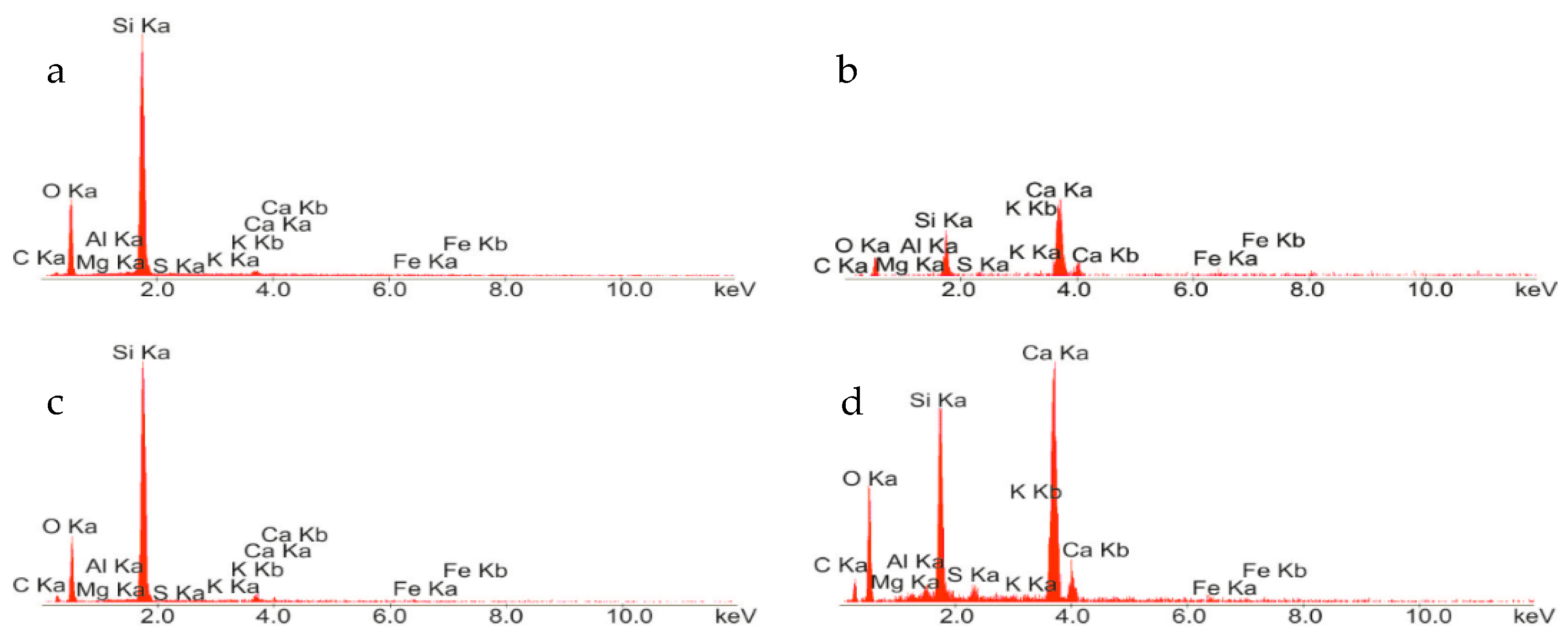
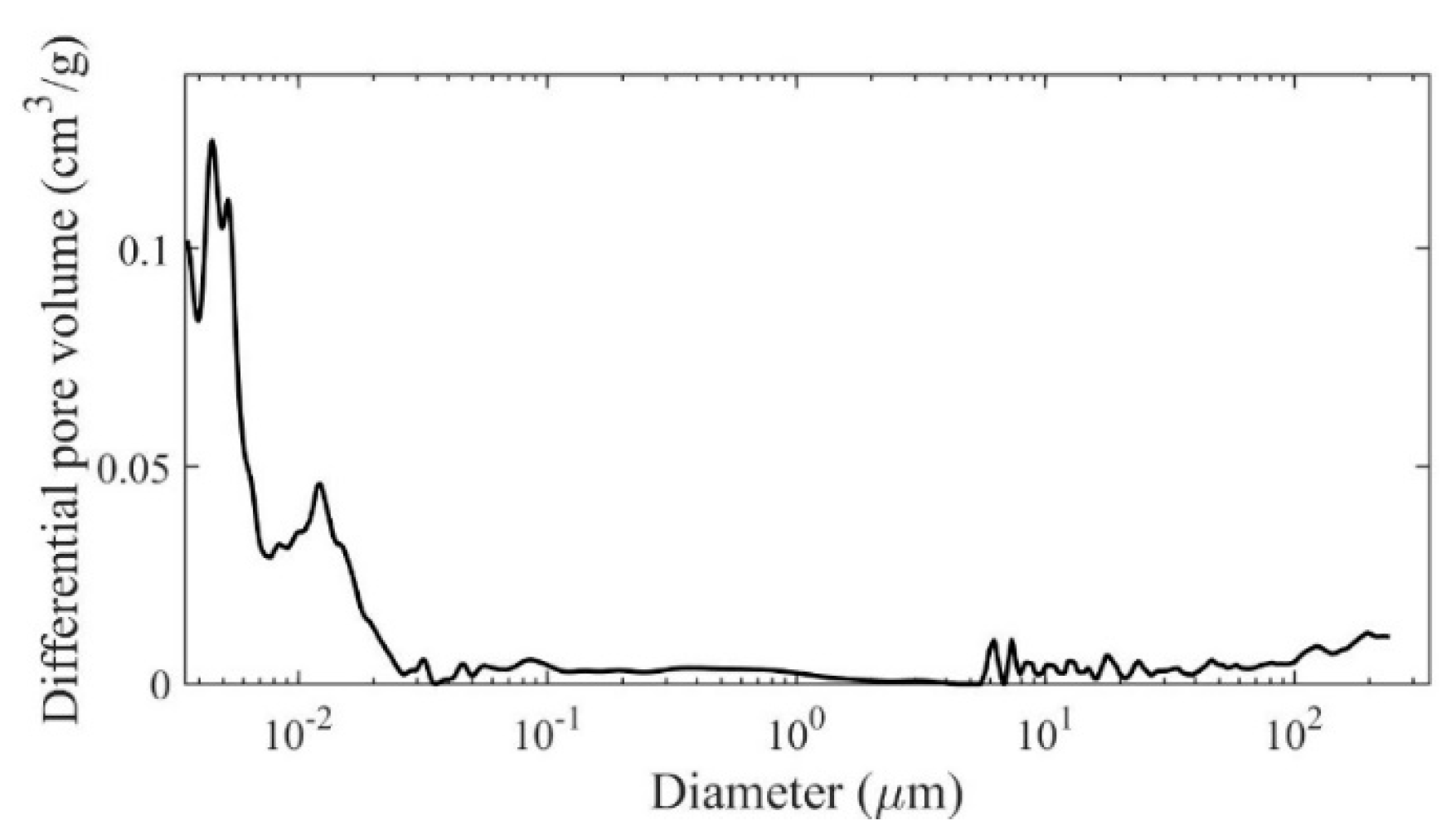


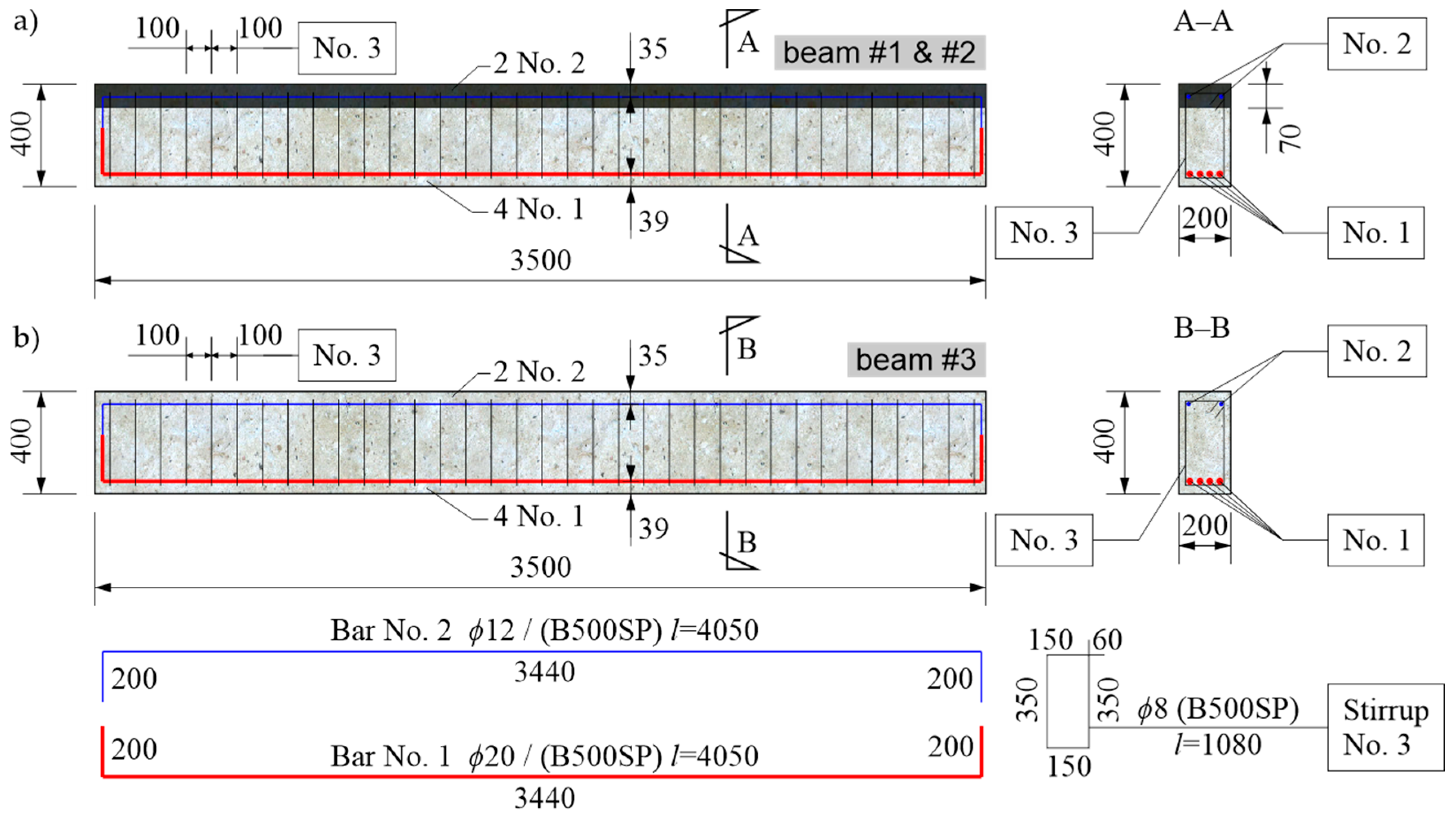


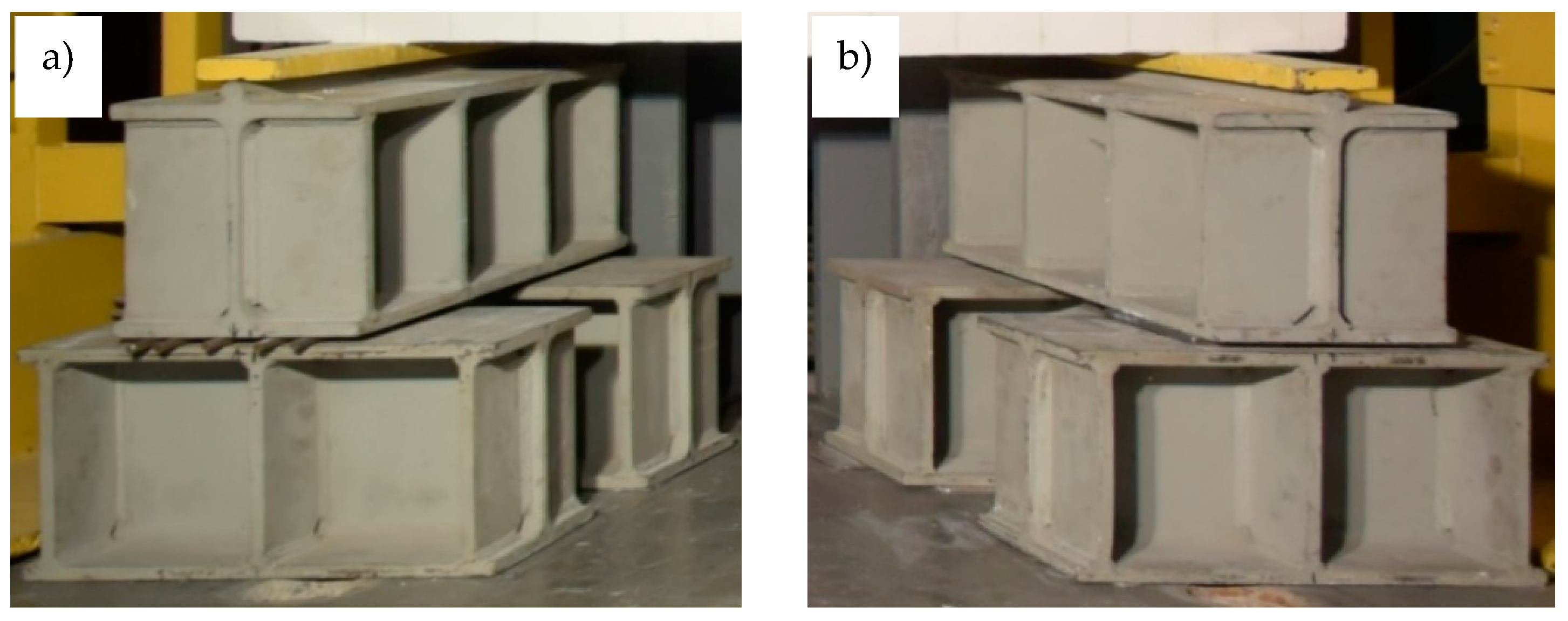
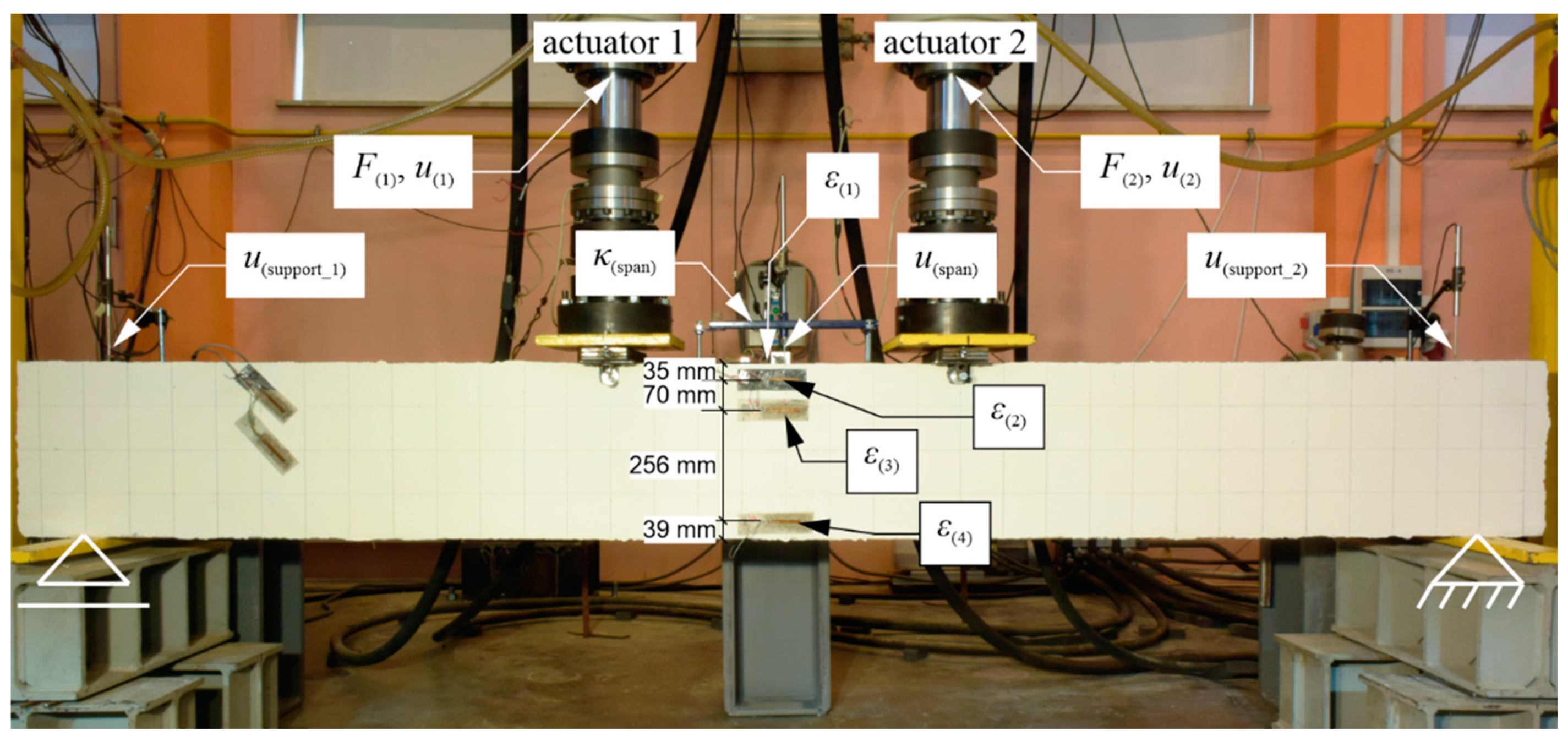
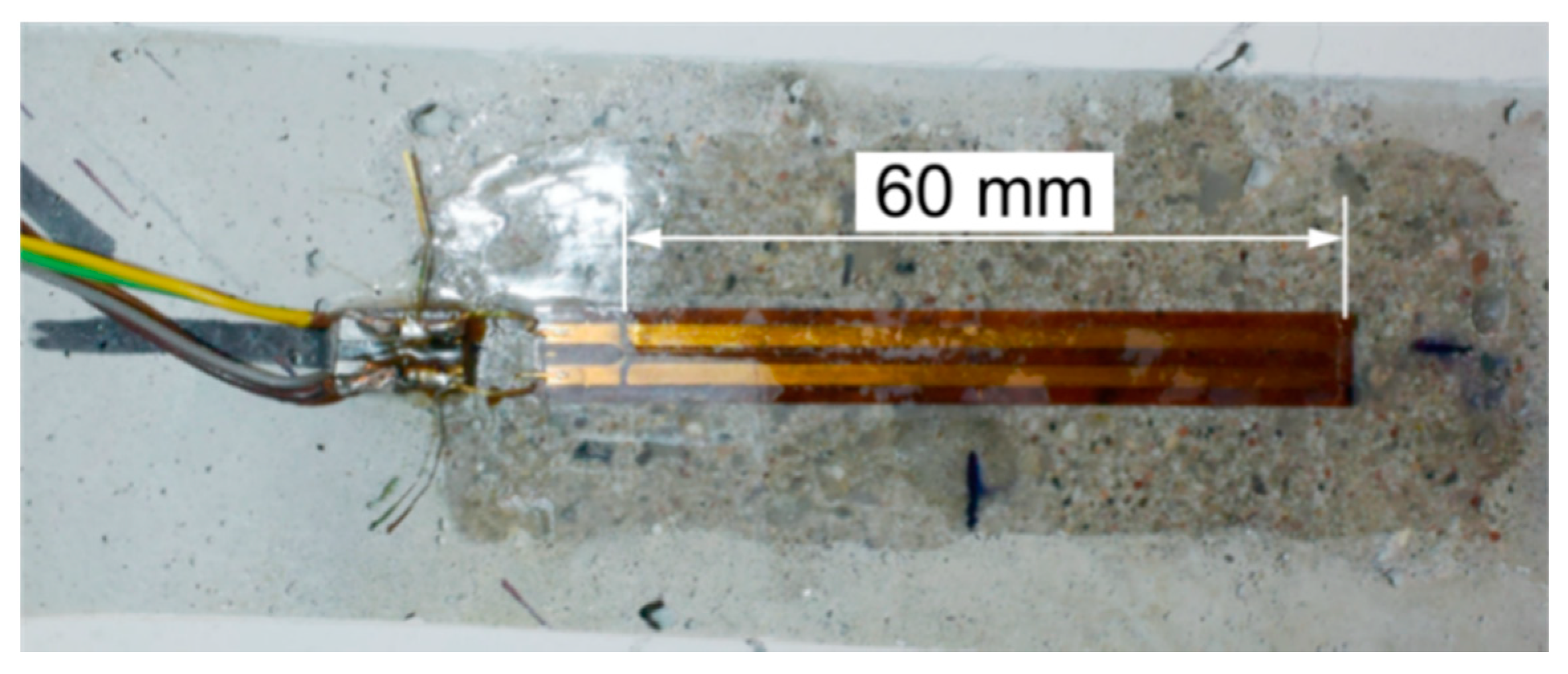

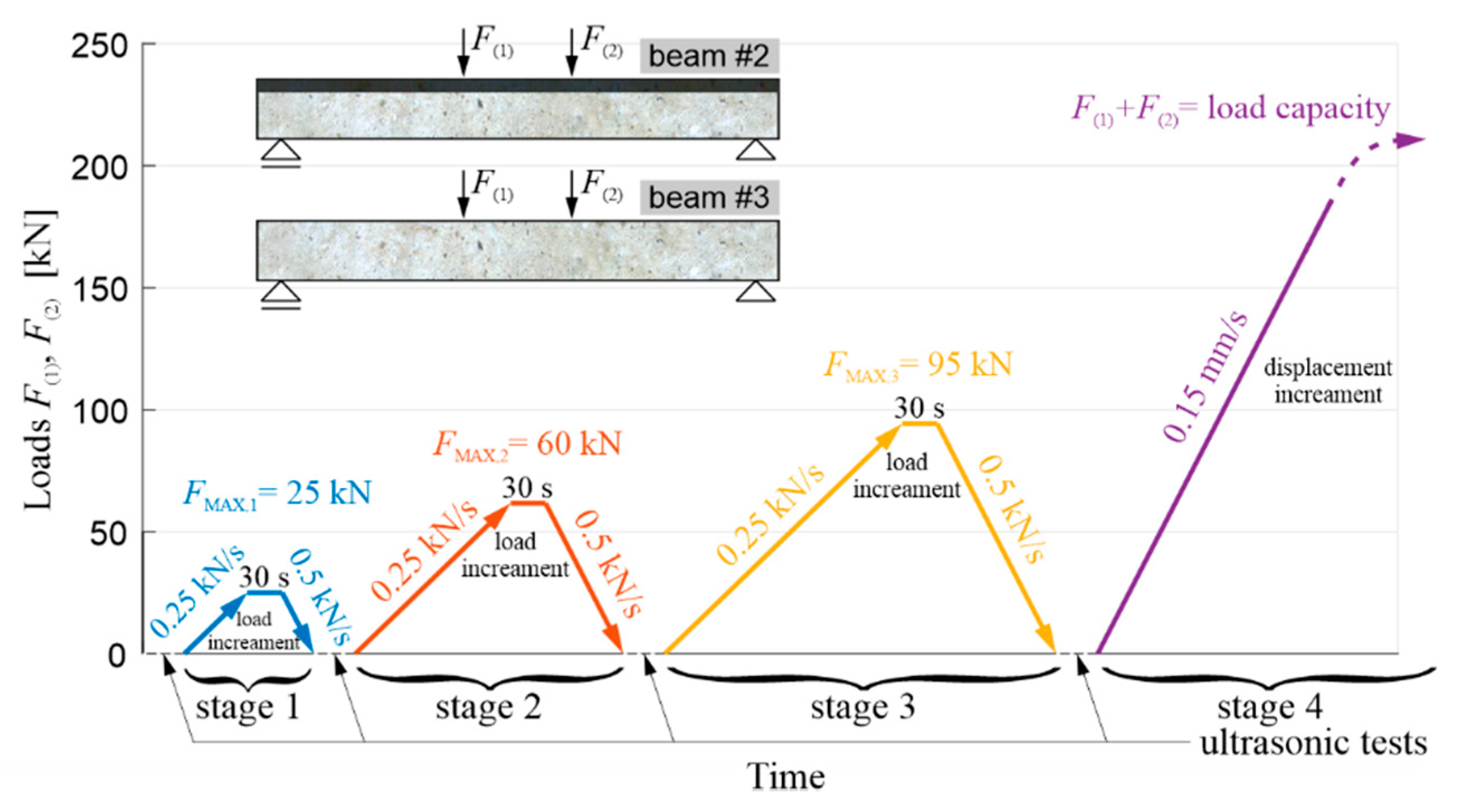
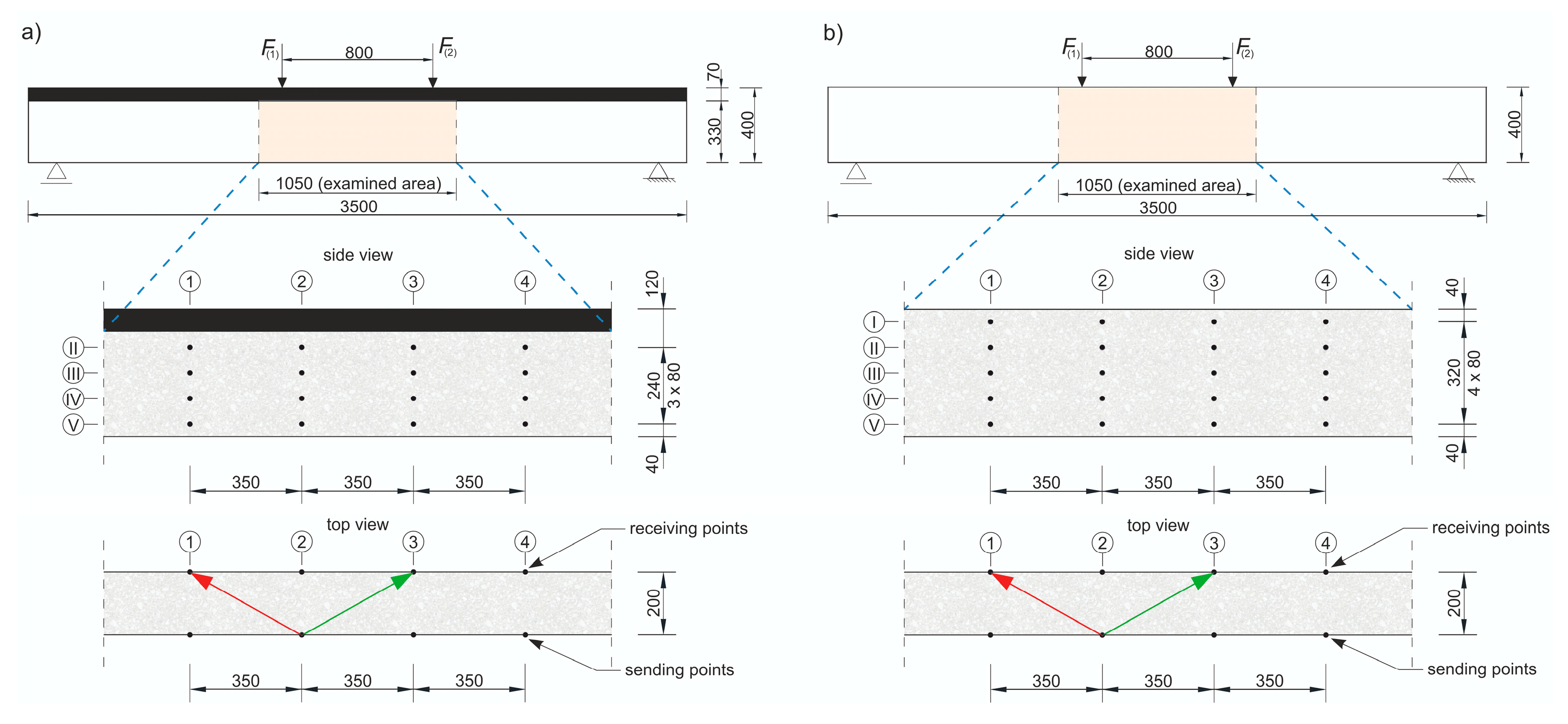

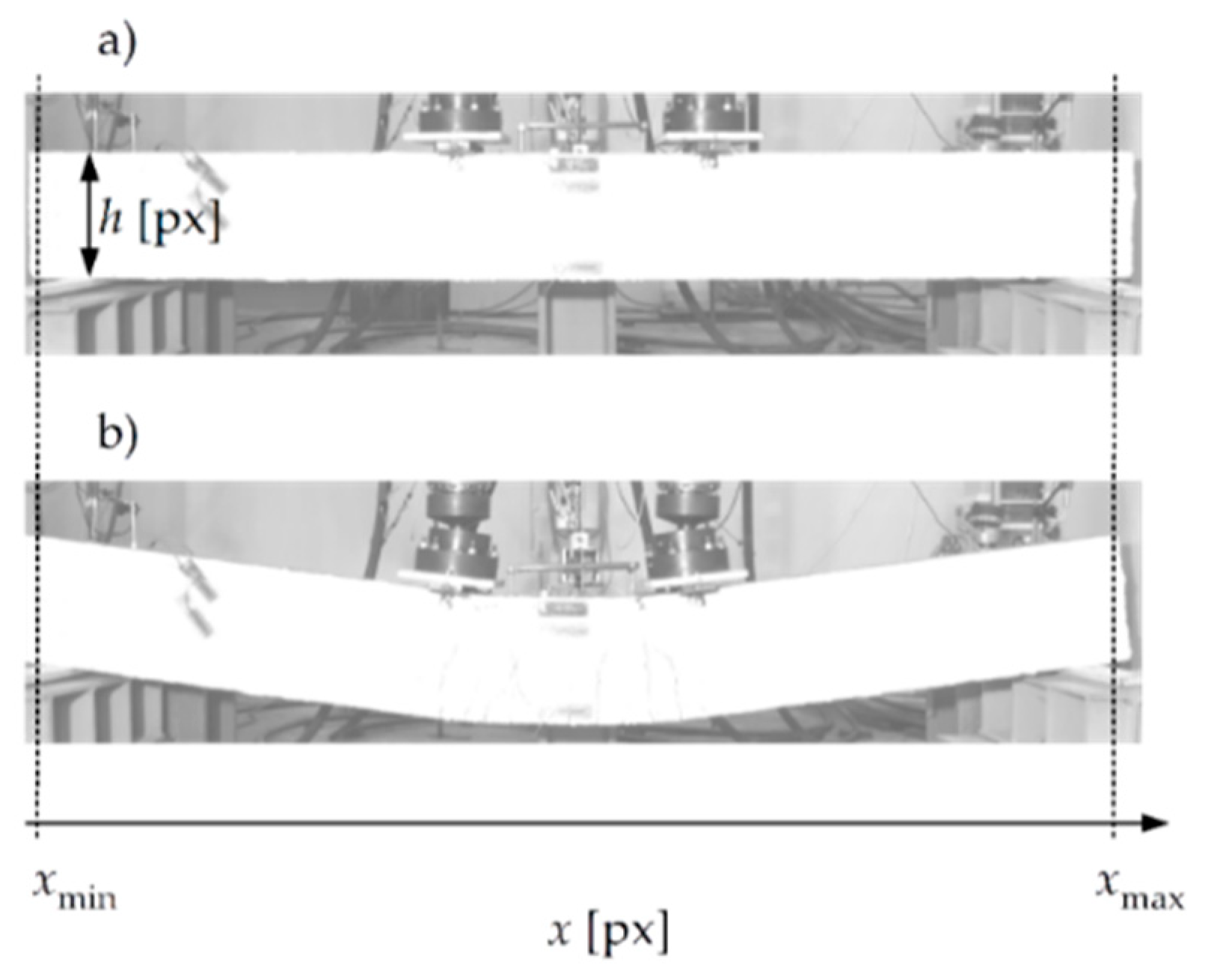
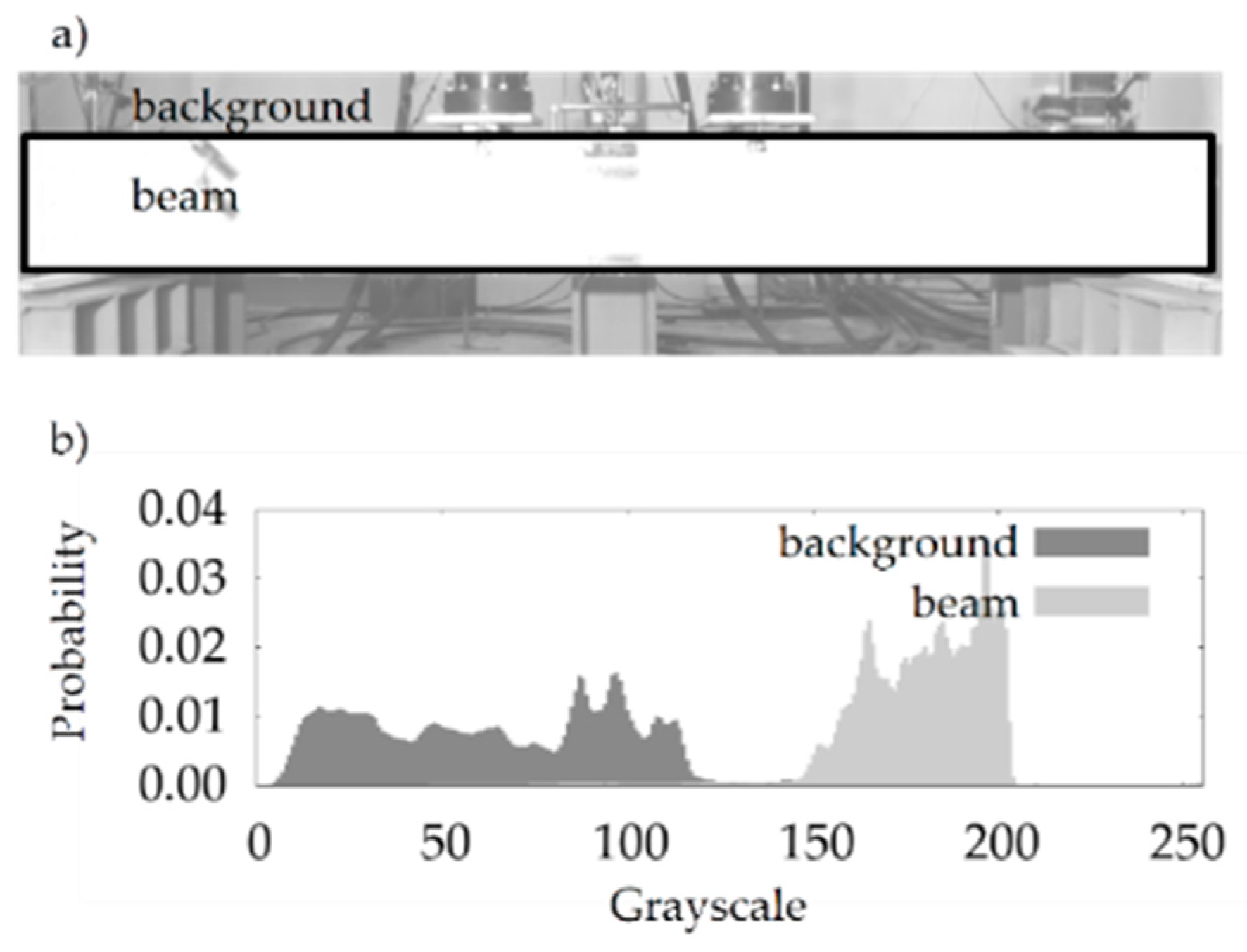
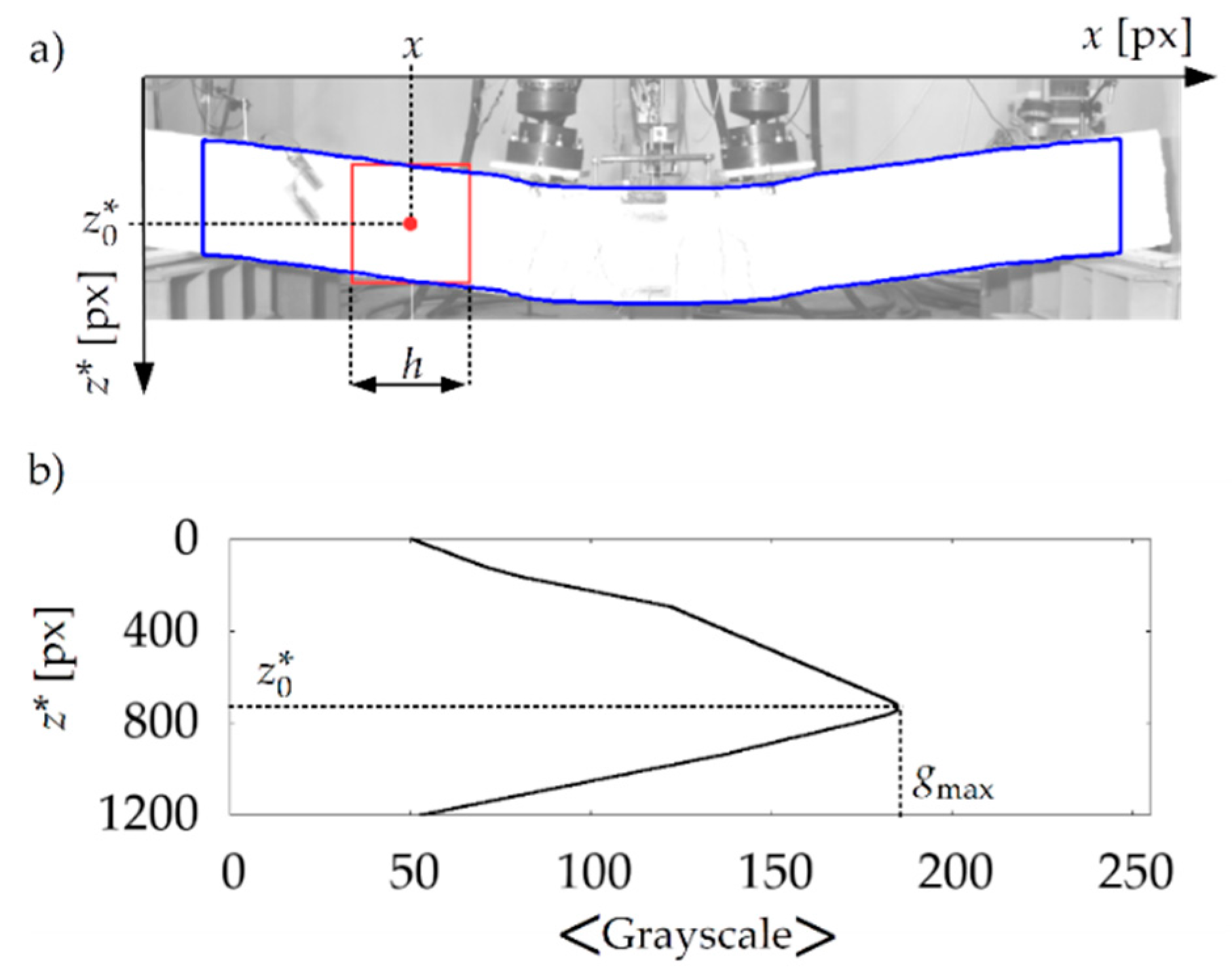
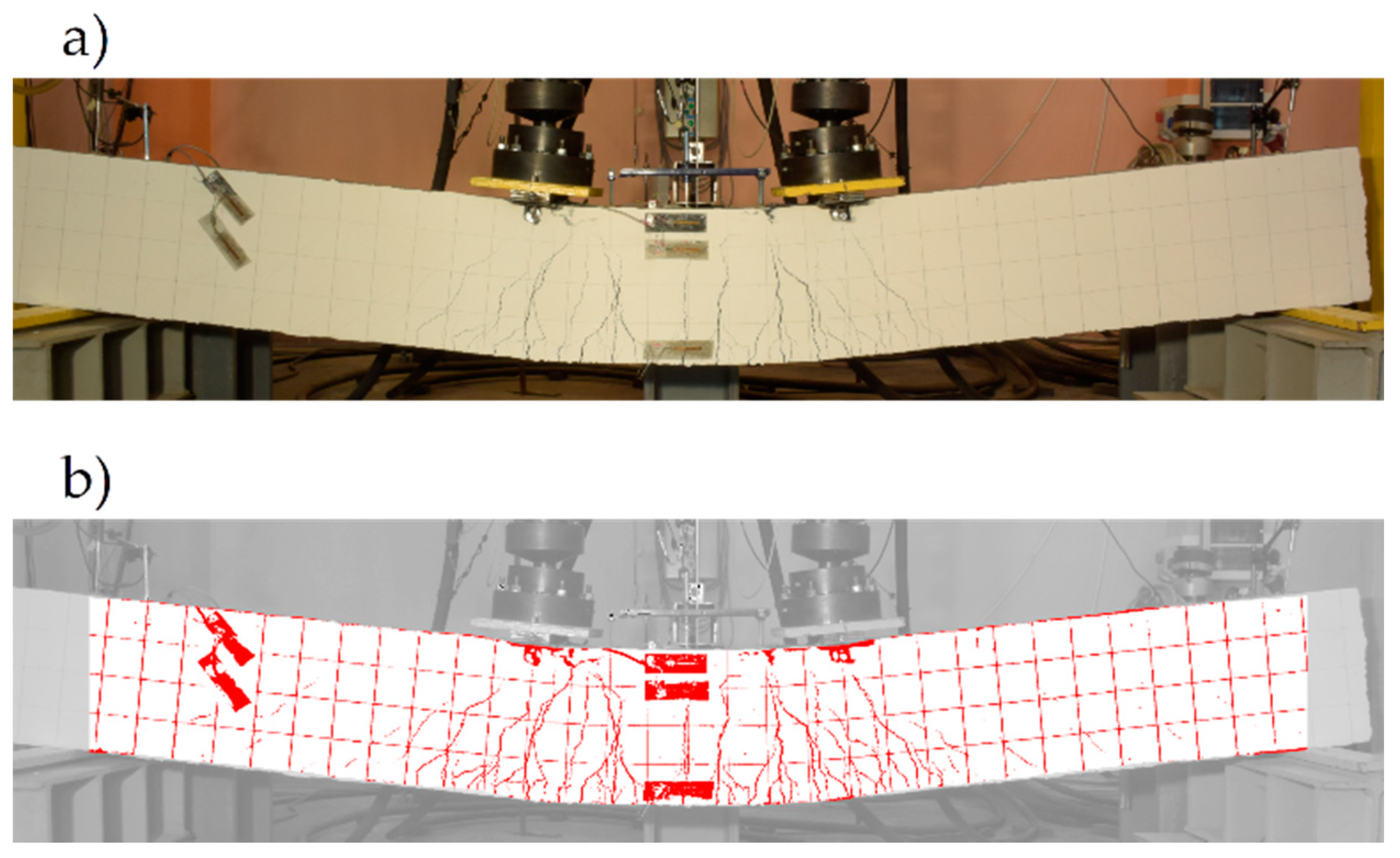

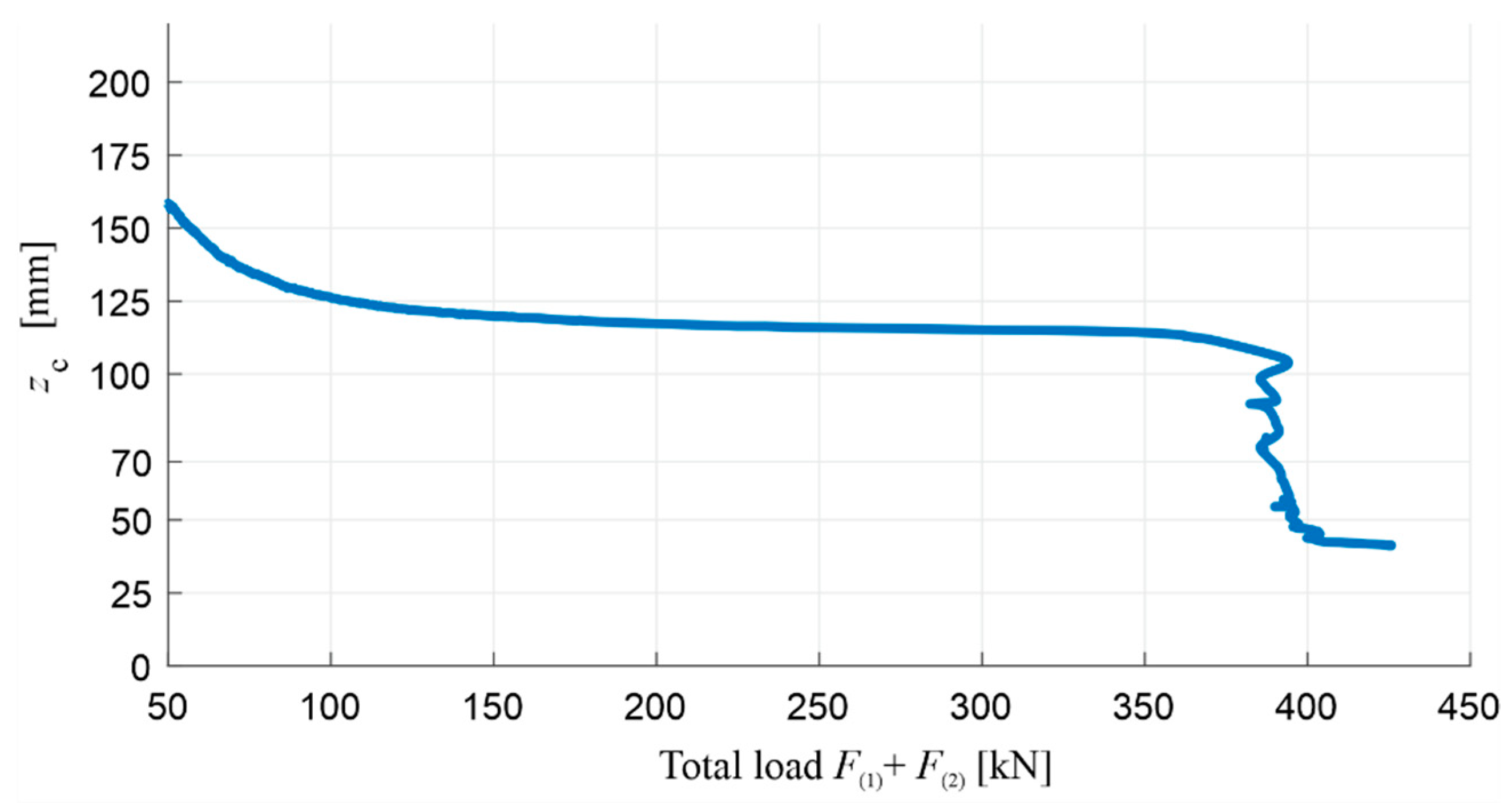
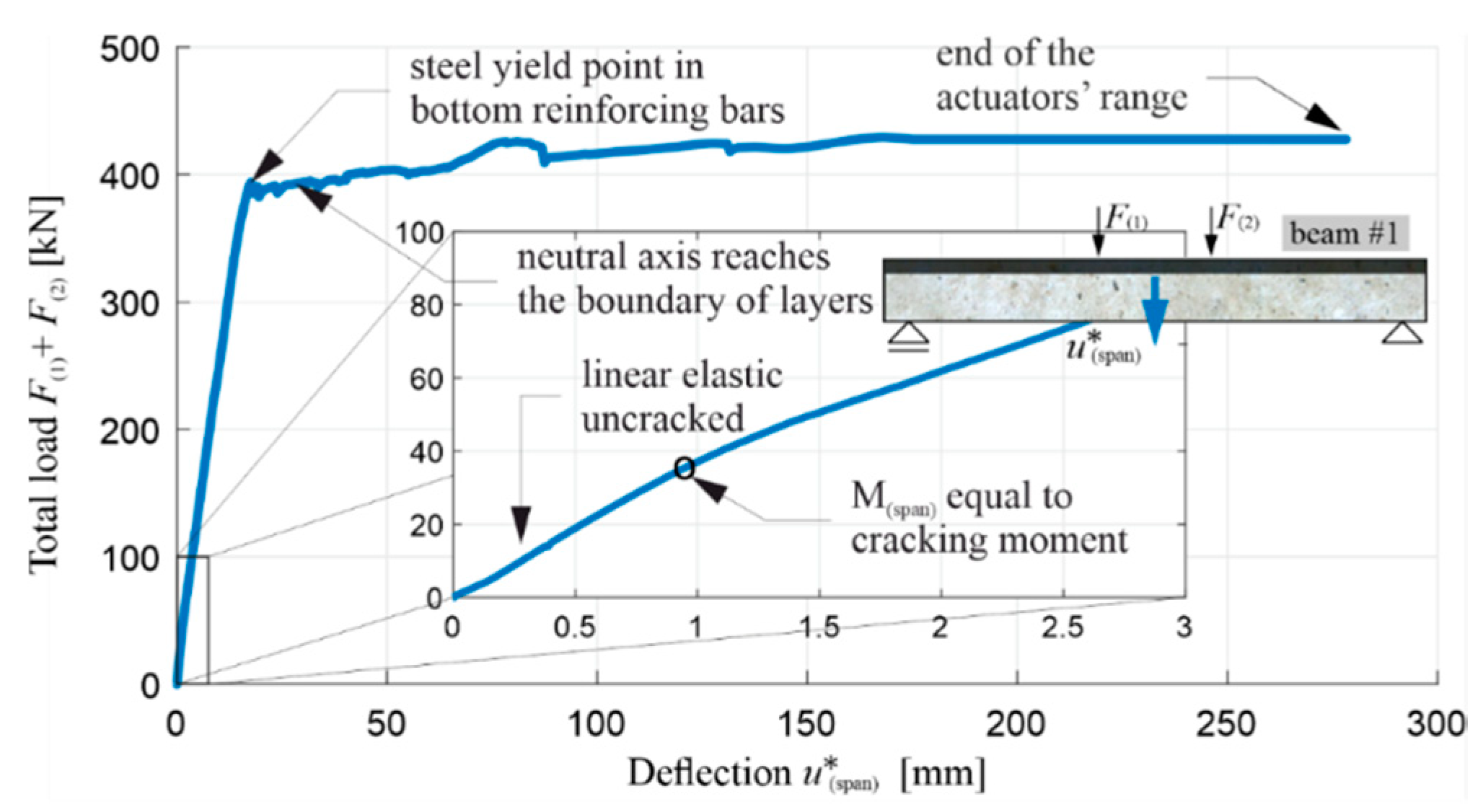
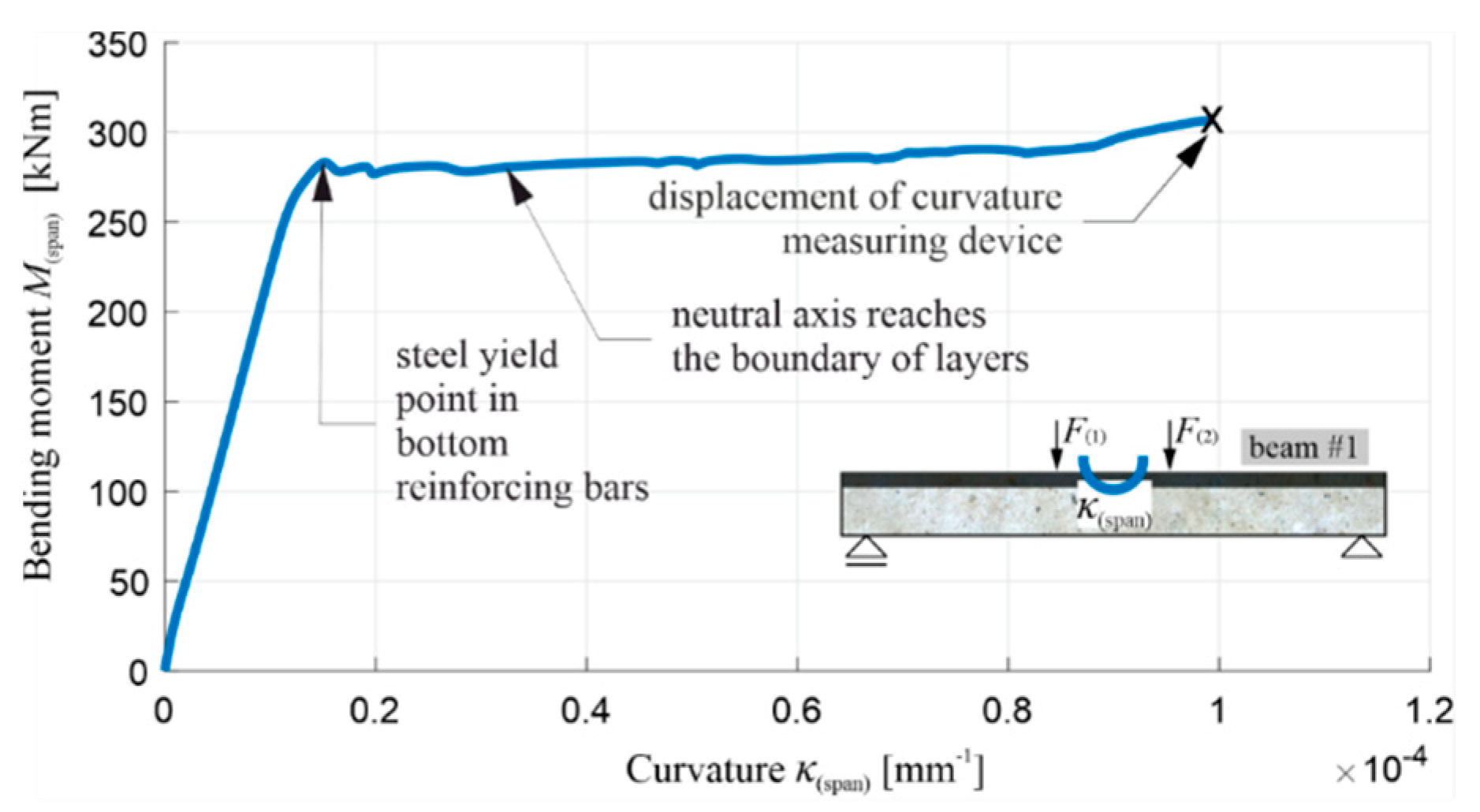


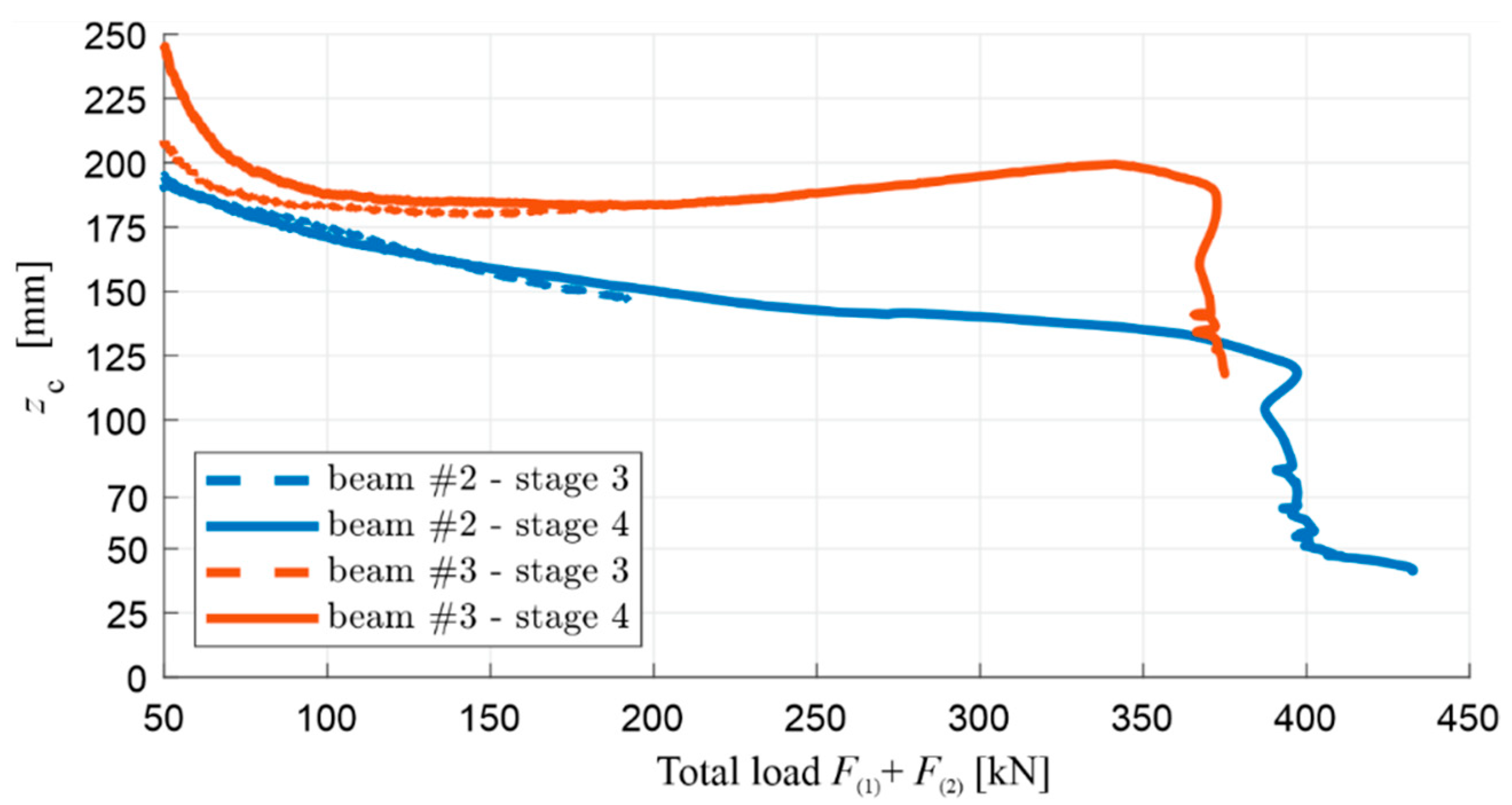
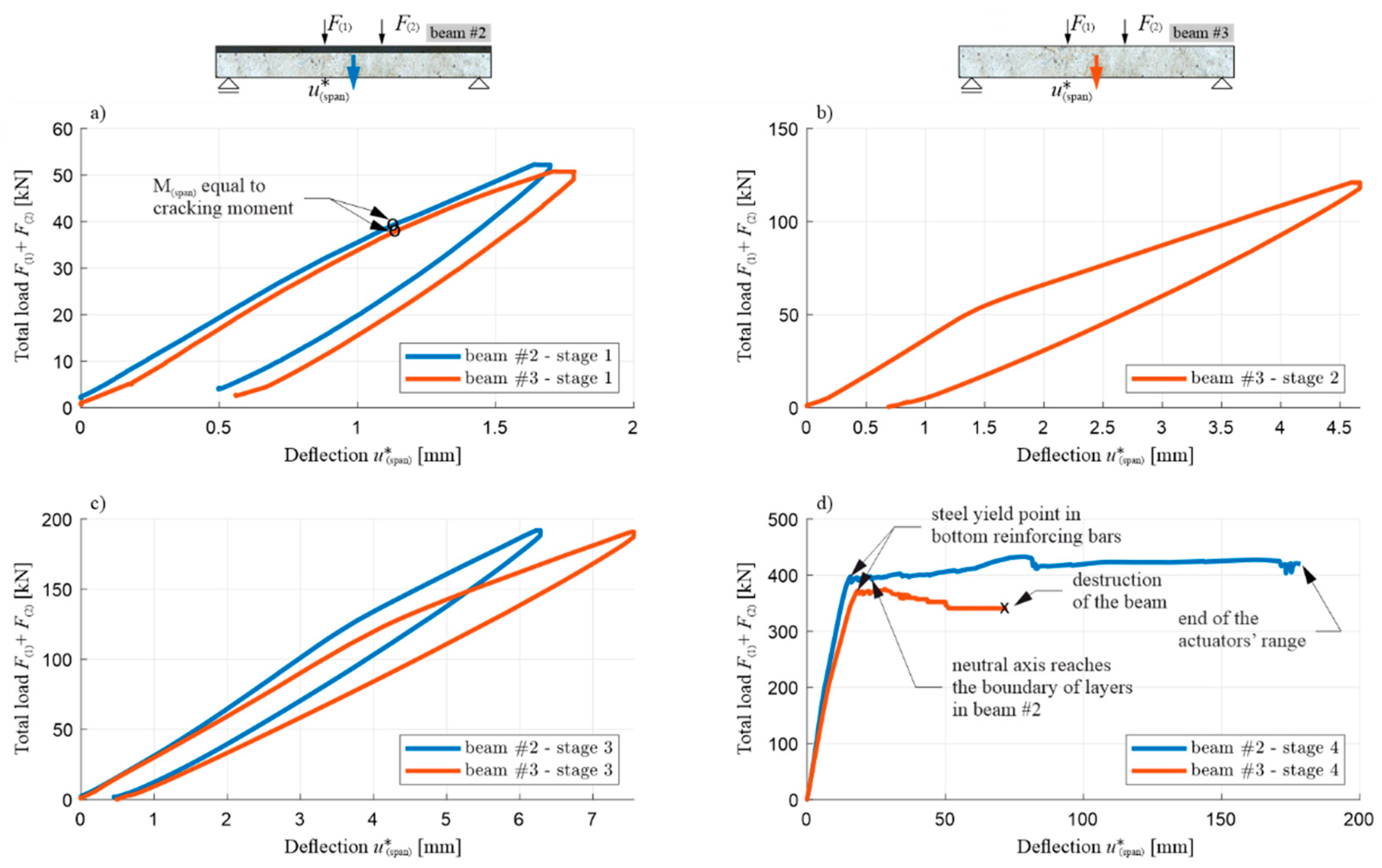
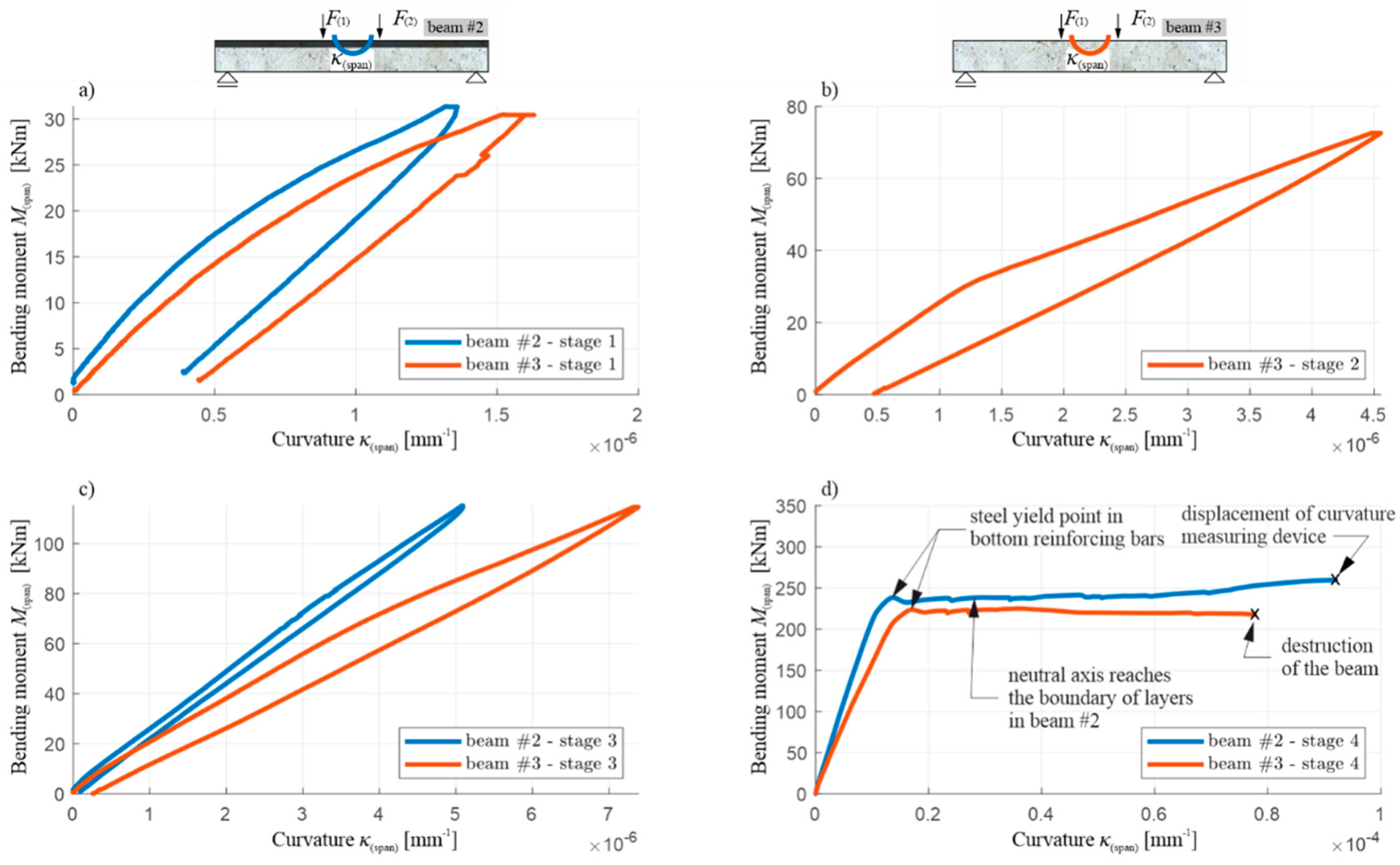
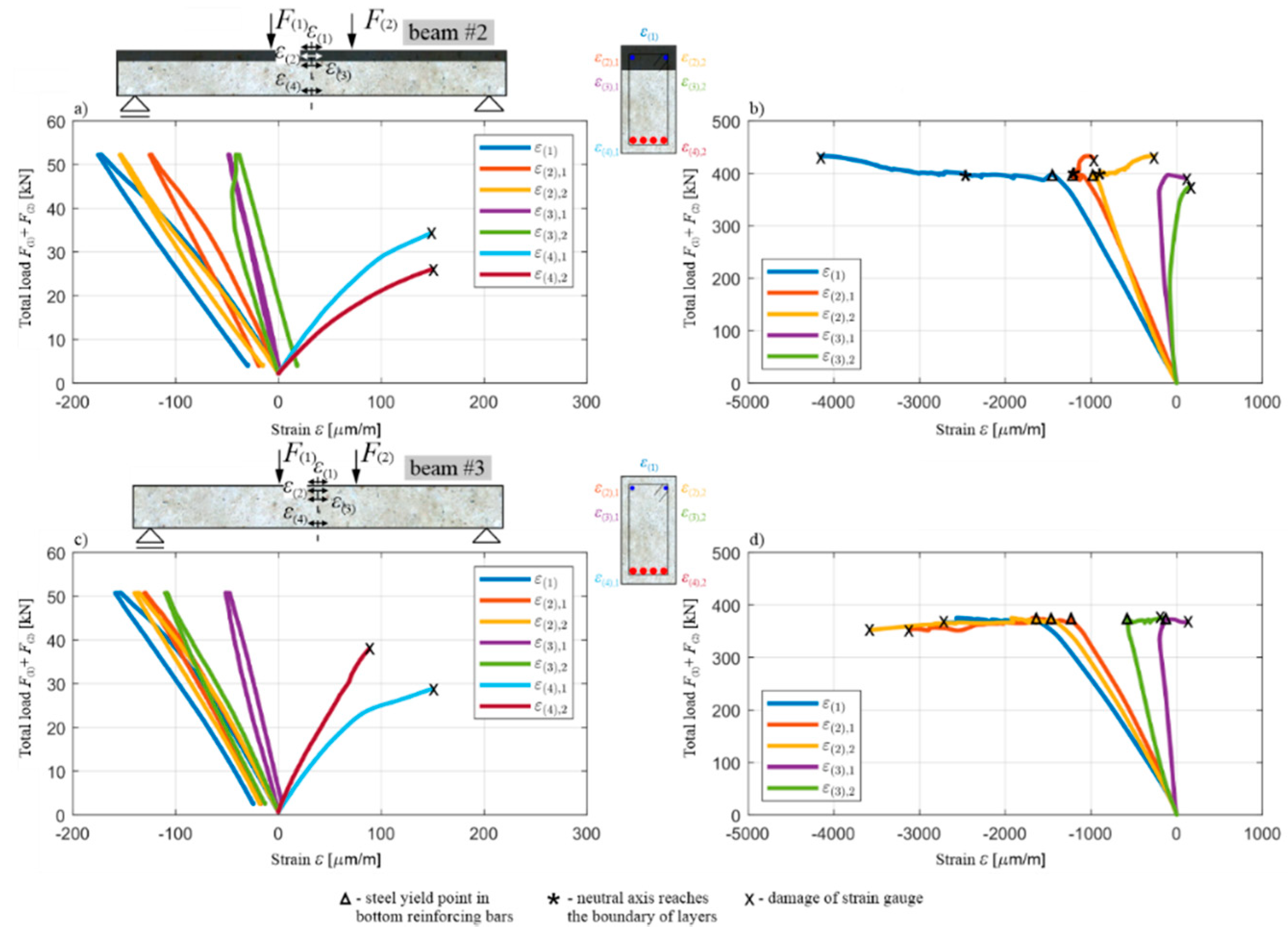

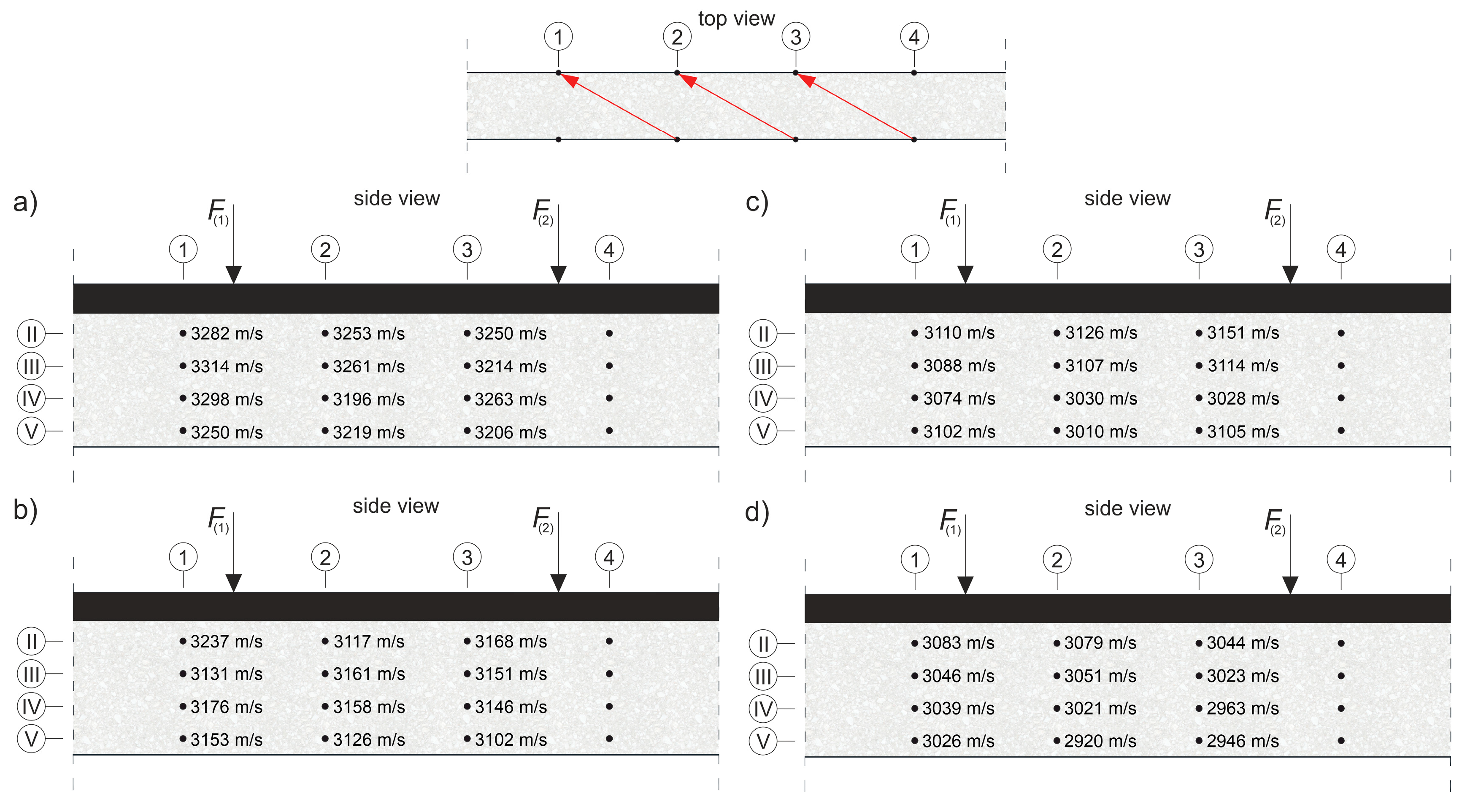

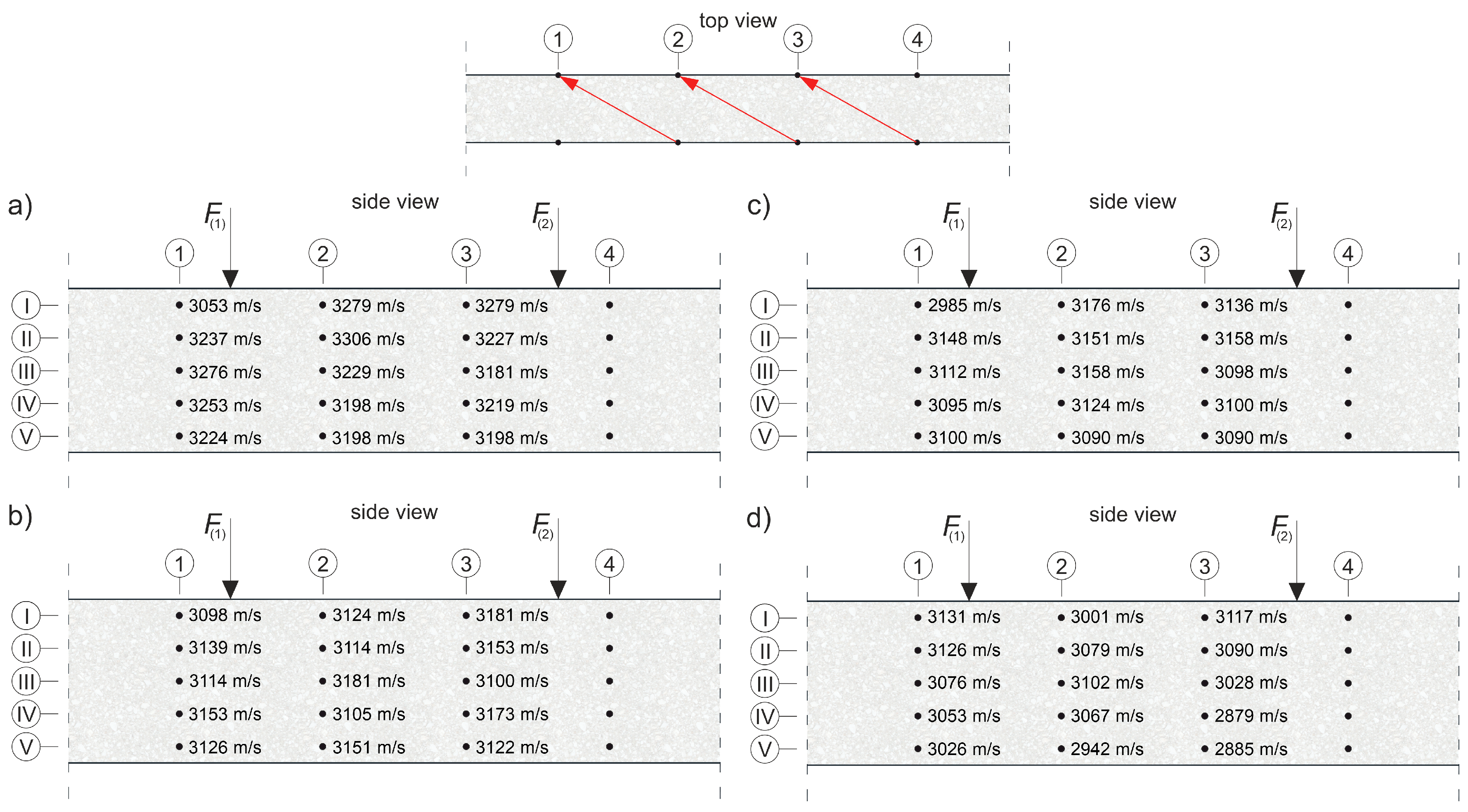
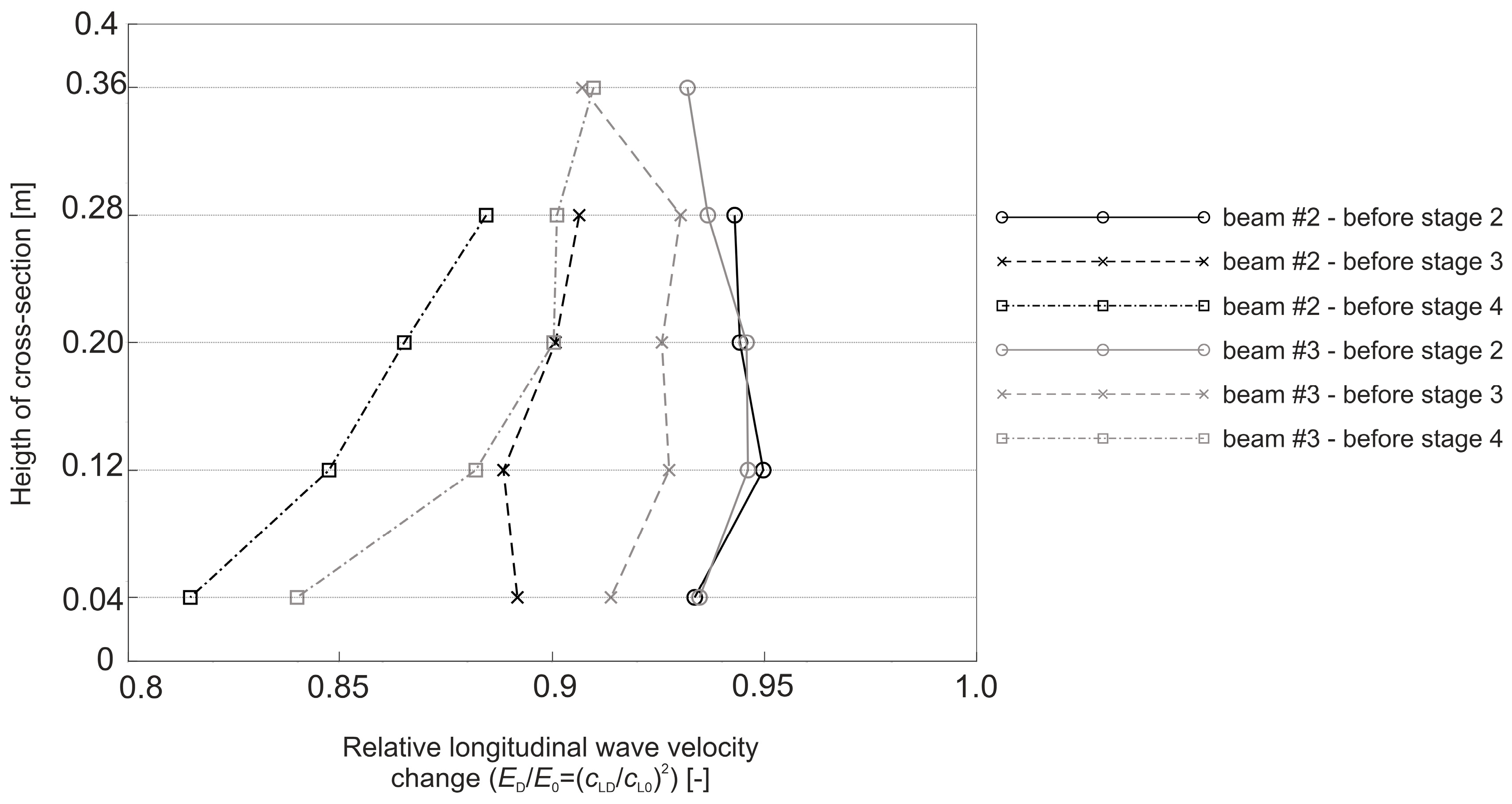

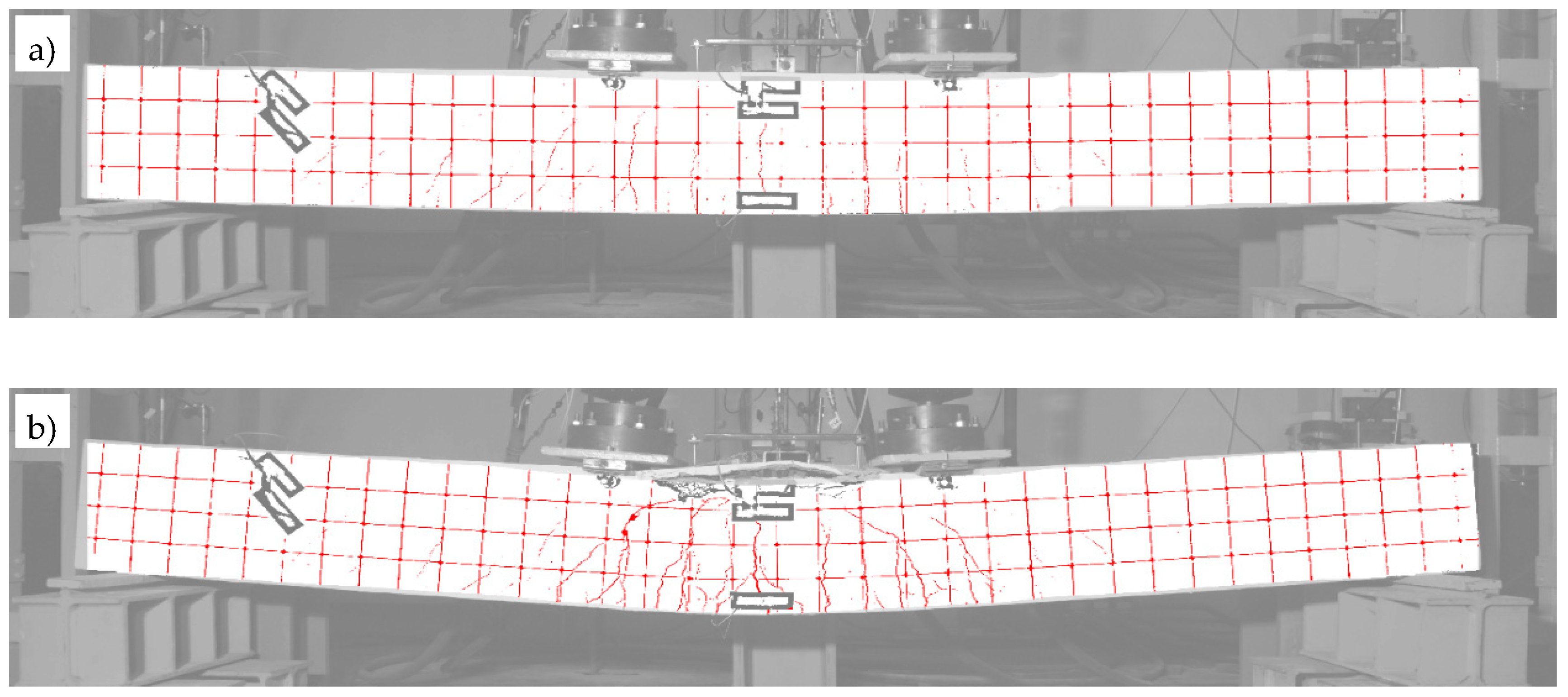
| Component | SiO2 | Fe2O3 | Al2O3 | CaO | MgO | SO3 | Na2O |
|---|---|---|---|---|---|---|---|
| Cement | 21.83 | 2.00 | 4.38 | 65.68 | 0.93 | 3.29 | 0.29 |
| Quartz powder | 99.0 | 0.05 | 0.29 | <0.1 | <0.1 | – | 0.2 |
| Quartz sand | 98.6 | 0.03 | 0.75 | – | – | – | – |
| Component | Weight Fraction Related to the Mass of Cement |
|---|---|
| Cement | 1.00 |
| Silica fume | 0.20 |
| Quartz powder | 0.12 |
| Quartz sand | 1.03 |
| Water | 0.24 |
| Steel fibres | 0.27 |
| Superplasticiser | 0.025 |
| Age of Concrete [days] | Compressive Strength [MPa] | Flexural Strength [MPa] |
|---|---|---|
| 1 | 95.2 | 36.0 |
| 2 | 145.7 | 48.2 |
| 7 | 166.8 | 49.6 |
| 28 | 197.9 | 51.9 |
| Total Porosity [%] | Percentage of Total Pore Volume Depending on the Diameter [%] | ||||
|---|---|---|---|---|---|
| <20 nm | 20–200 nm | 200–2000 nm | 2000–20,000 nm | >20,000 nm | |
| 4.4 | 77.1 | 8.0 | 3.6 | 2.5 | 8.8 |
| Description of the Beam’s State | ||||
|---|---|---|---|---|
| Cracking moment | 38 | 22.8 | 1.0 | 0.084 |
| Steel yield point in the bottom reinforcing bars | 394.1 | 236.5 | 17.6 | 1.524 |
| Neutral axis reaches the boundary of the layers | 389.1 | 233.5 | 24.8 | 3.162 |
| End of the actuators’ travel range | 422.3 | 253.4 | 278.5 | ND |
| Description of the Beams’ State | ||||||||
|---|---|---|---|---|---|---|---|---|
| Beam | #2 | #3 | #2 | #3 | #2 | #3 | #2 | #3 |
| Cracking moment in stage 1 | 39.0 | 38.0 | 23.4 | 22.8 | 1.1 | 1.1 | 0.081 | 0.093 |
| Maximum load in stage 1 | 52.2 | 50.7 | 31.3 | 30.4 | 1.6 | 1.7 | 0.132 | 0.153 |
| Maximum load in stage 2 | 122.0 | 121.0 | 73.2 | 72.6 | ND | 4.6 | ND | 0.448 |
| Maximum load in stage 3 | 191.8 | 191.5 | 115.1 | 114.9 | 6.2 | 7.6 | 0.508 | 0.737 |
| Steel yield point in the bottom reinforcing bars in stage 4 | 397.1 | 372.5 | 238.3 | 223.5 | 15.6 | 18.3 | 1.371 | 1.687 |
| Neutral axis reaches the boundary of the layers in beam #2 during stage 4 | 397.3 | ND | 238.4 | ND | 21.6 | ND | 3.042 | ND |
| End of stage 4: end of the actuators’ travel range for beam #2 and destruction of beam #3. | 419.6 | 361.6 | 251.8 | 217.0 | 178.5 | 71.5 | ND | 7.820 |
© 2020 by the authors. Licensee MDPI, Basel, Switzerland. This article is an open access article distributed under the terms and conditions of the Creative Commons Attribution (CC BY) license (http://creativecommons.org/licenses/by/4.0/).
Share and Cite
Perkowski, Z.; Czabak, M.; Grzeszczyk, S.; Frączek, D.; Tatara, K.; Matuszek-Chmurowska, A.; Jurowski, K.; Jędraszak, B. Experimental Research on Concrete Beams Reinforced with High Ductility Steel Bars and Strengthened with a Reactive Powder Concrete Layer in the Compression Zone. Materials 2020, 13, 4173. https://doi.org/10.3390/ma13184173
Perkowski Z, Czabak M, Grzeszczyk S, Frączek D, Tatara K, Matuszek-Chmurowska A, Jurowski K, Jędraszak B. Experimental Research on Concrete Beams Reinforced with High Ductility Steel Bars and Strengthened with a Reactive Powder Concrete Layer in the Compression Zone. Materials. 2020; 13(18):4173. https://doi.org/10.3390/ma13184173
Chicago/Turabian StylePerkowski, Zbigniew, Mariusz Czabak, Stefania Grzeszczyk, Daniel Frączek, Karolina Tatara, Aneta Matuszek-Chmurowska, Krystian Jurowski, and Bronisław Jędraszak. 2020. "Experimental Research on Concrete Beams Reinforced with High Ductility Steel Bars and Strengthened with a Reactive Powder Concrete Layer in the Compression Zone" Materials 13, no. 18: 4173. https://doi.org/10.3390/ma13184173
APA StylePerkowski, Z., Czabak, M., Grzeszczyk, S., Frączek, D., Tatara, K., Matuszek-Chmurowska, A., Jurowski, K., & Jędraszak, B. (2020). Experimental Research on Concrete Beams Reinforced with High Ductility Steel Bars and Strengthened with a Reactive Powder Concrete Layer in the Compression Zone. Materials, 13(18), 4173. https://doi.org/10.3390/ma13184173




